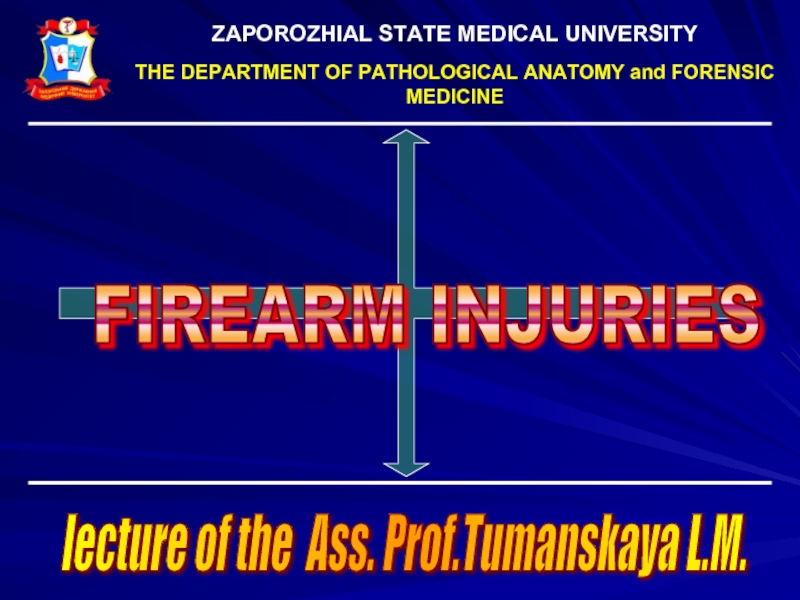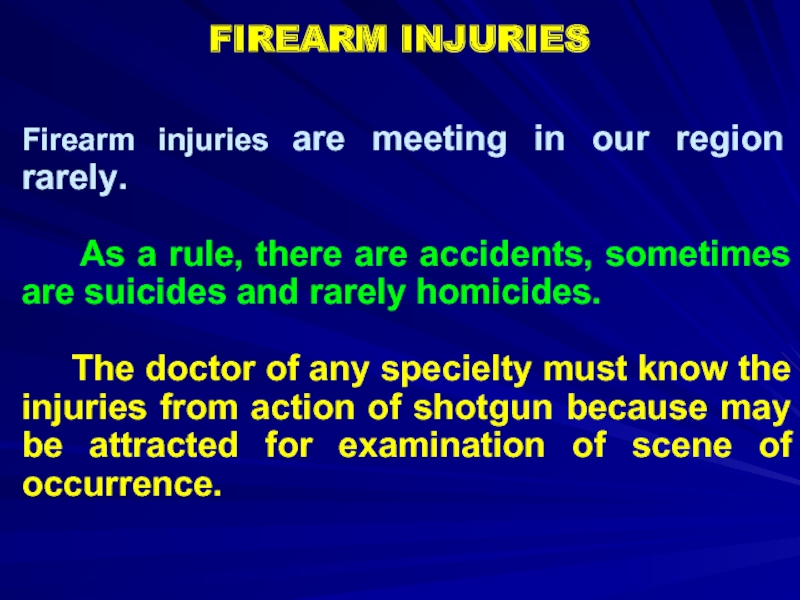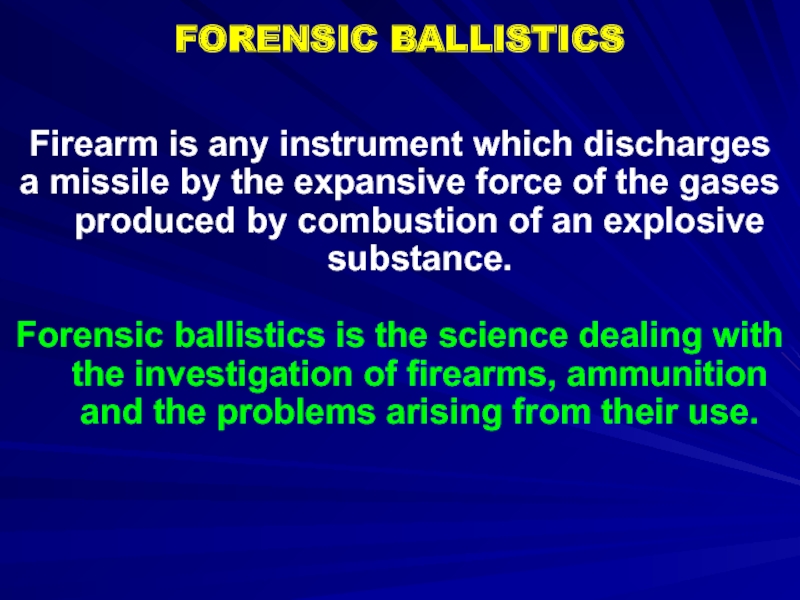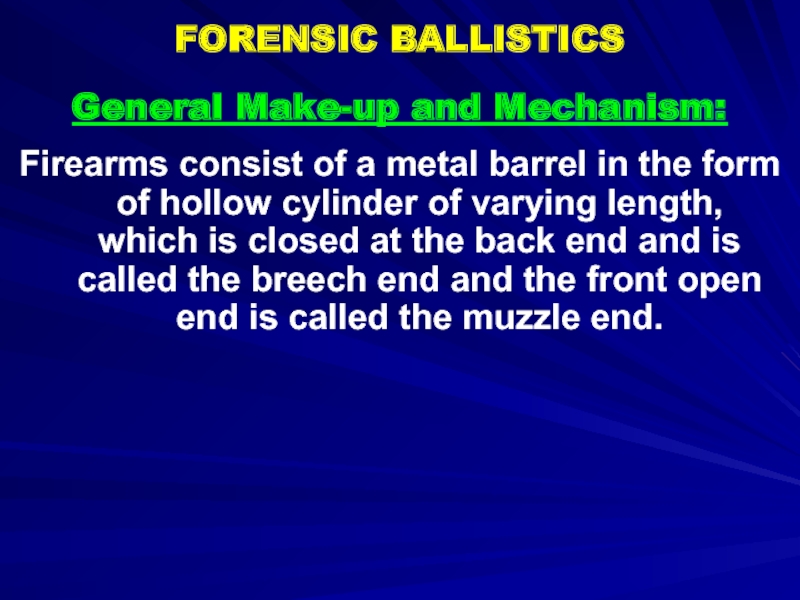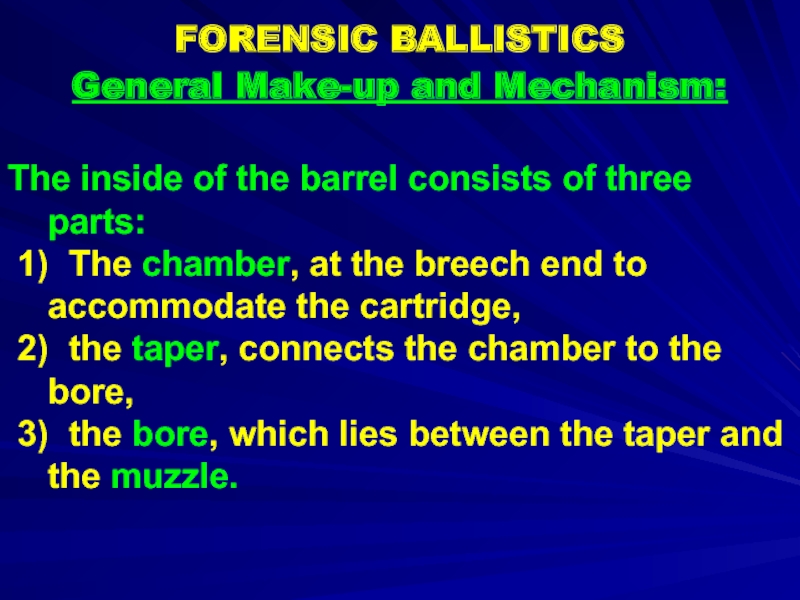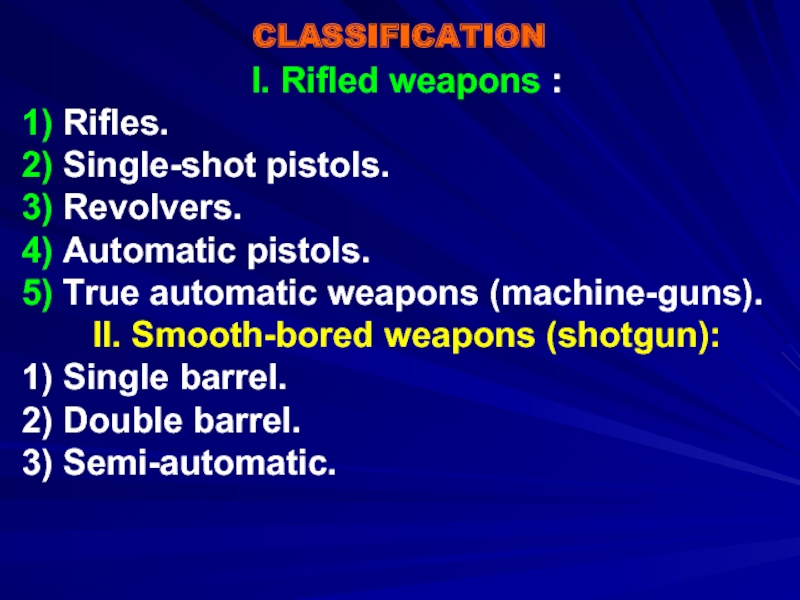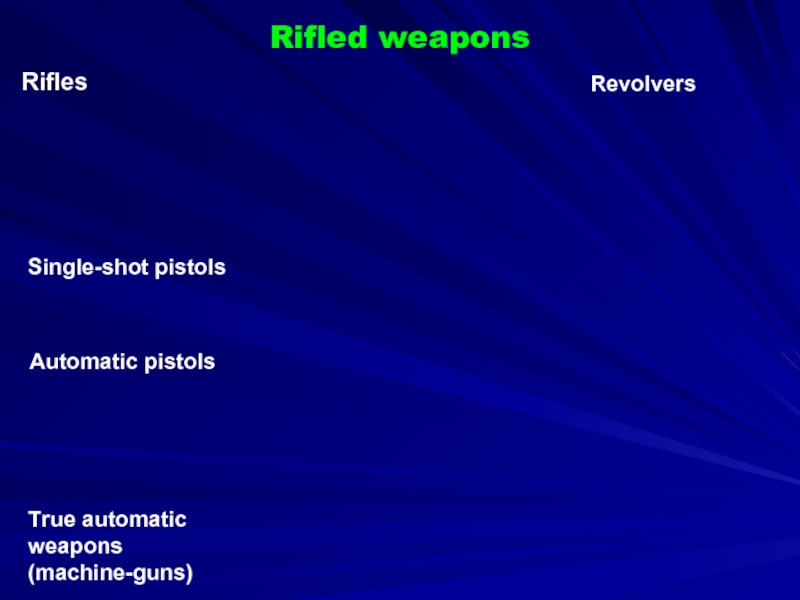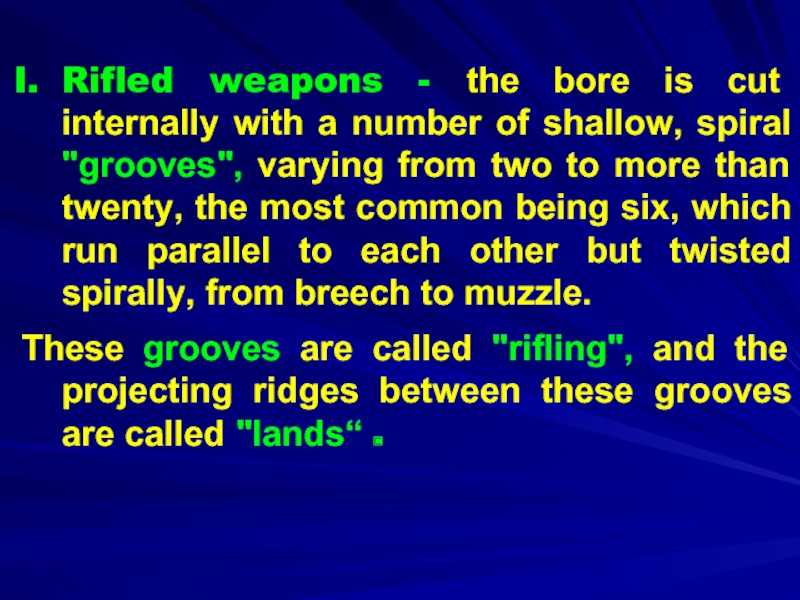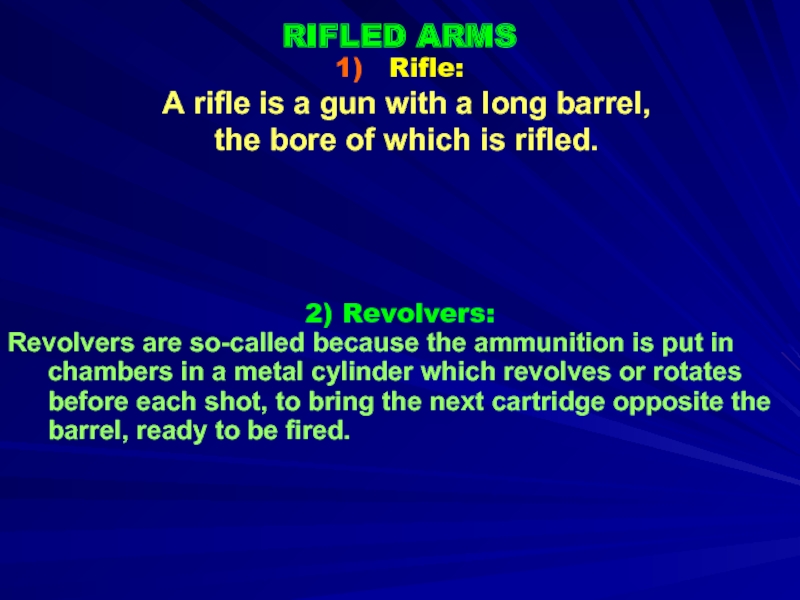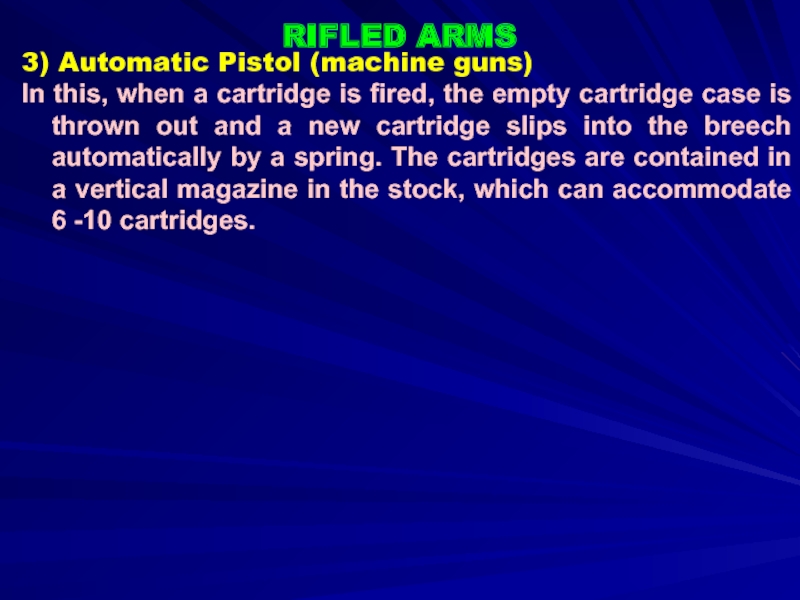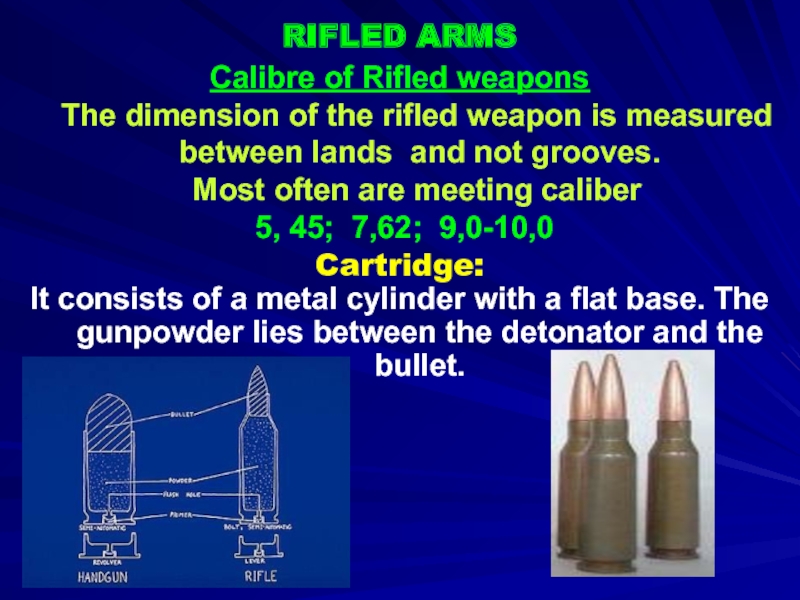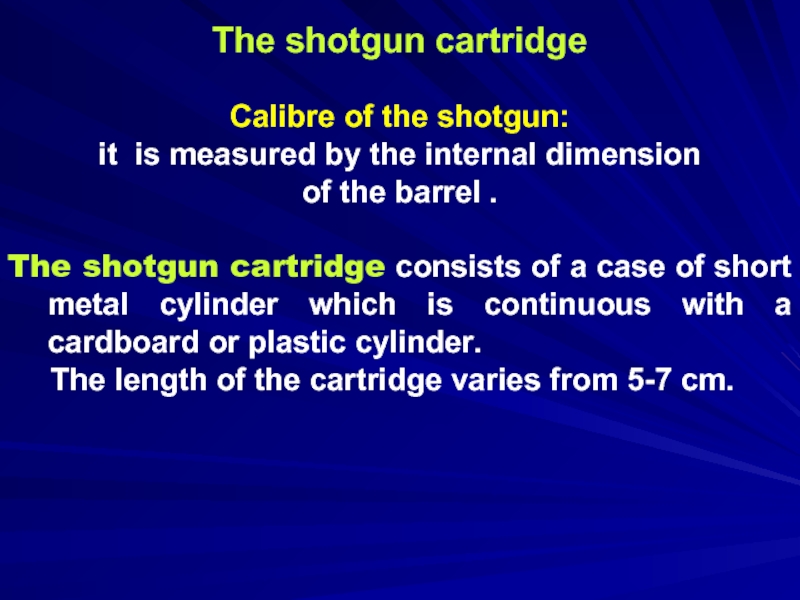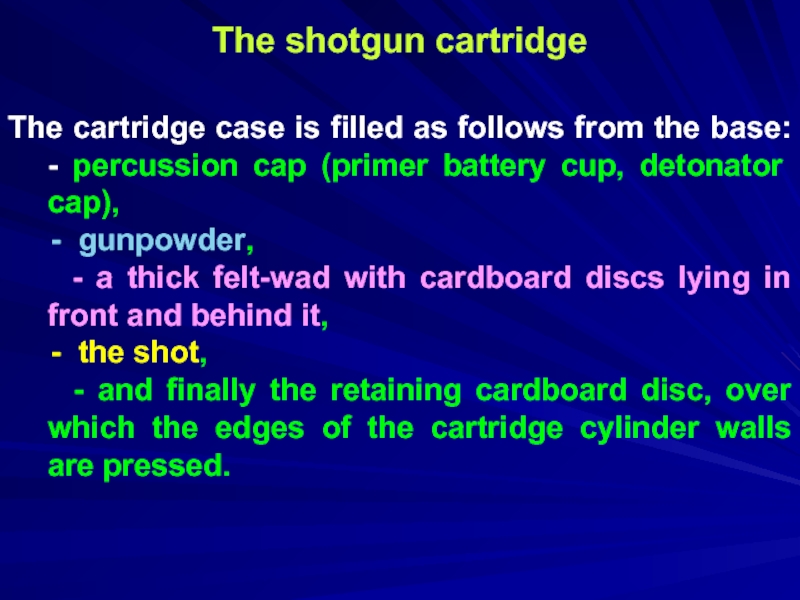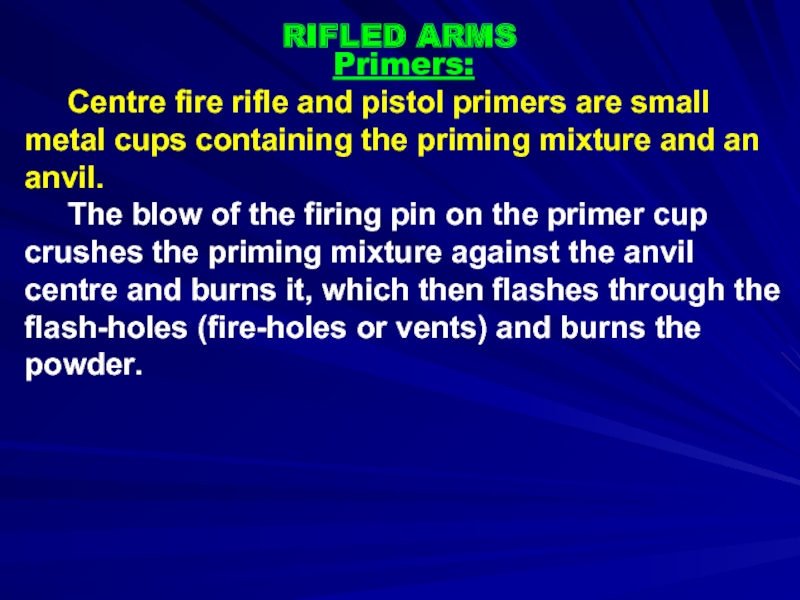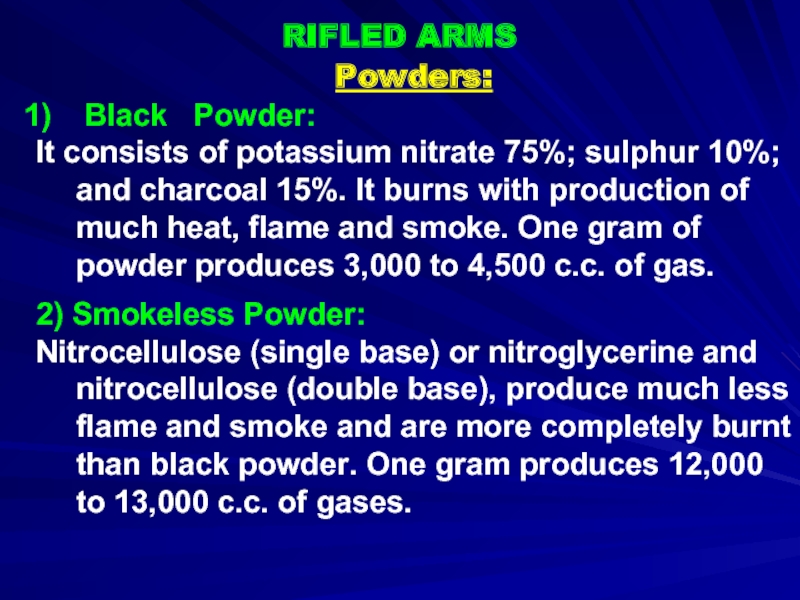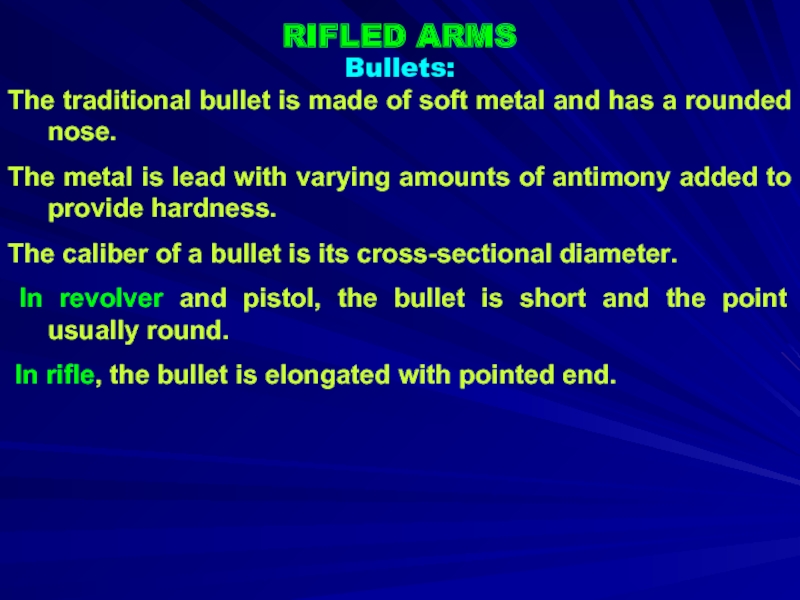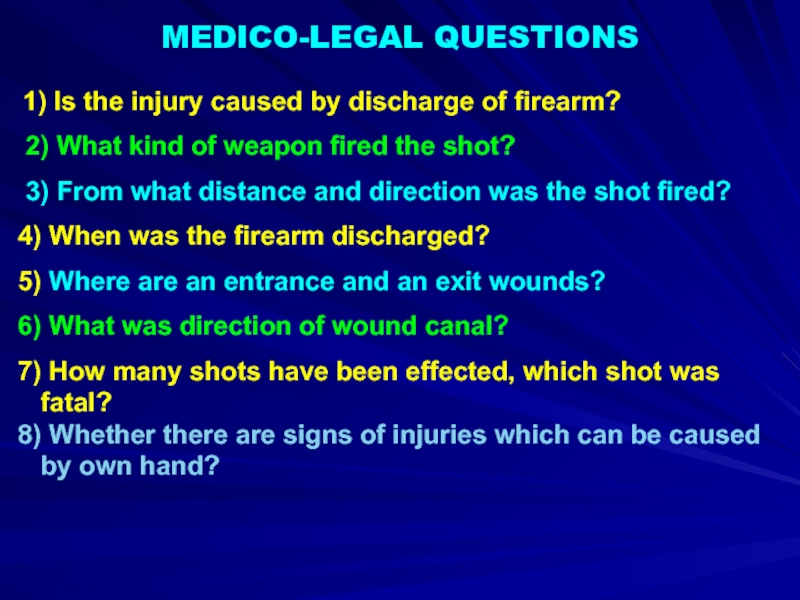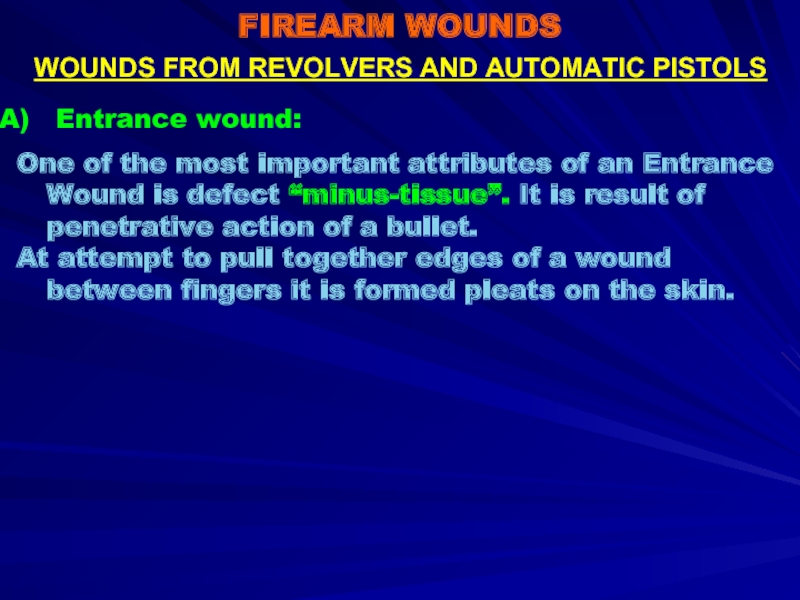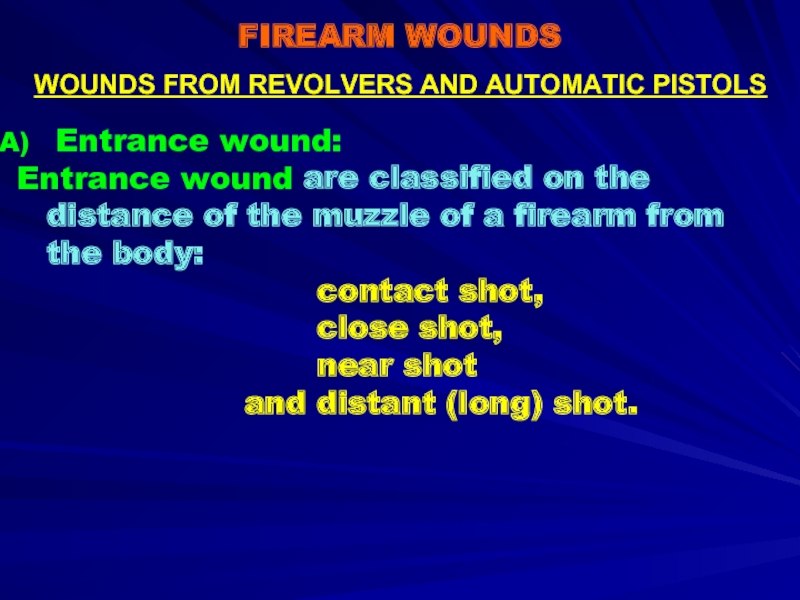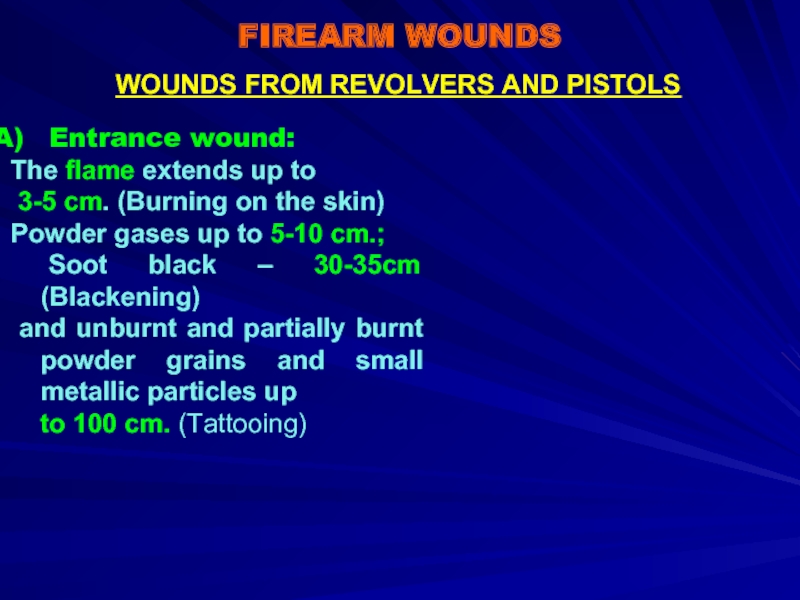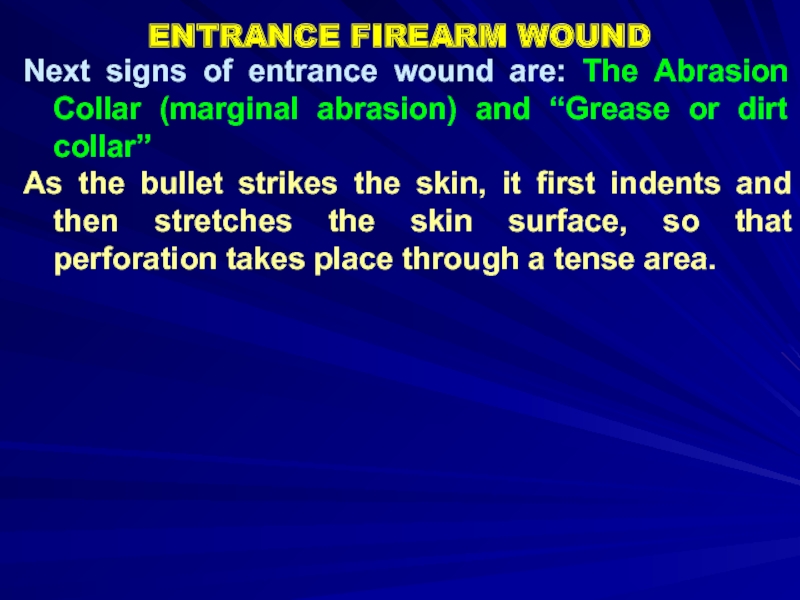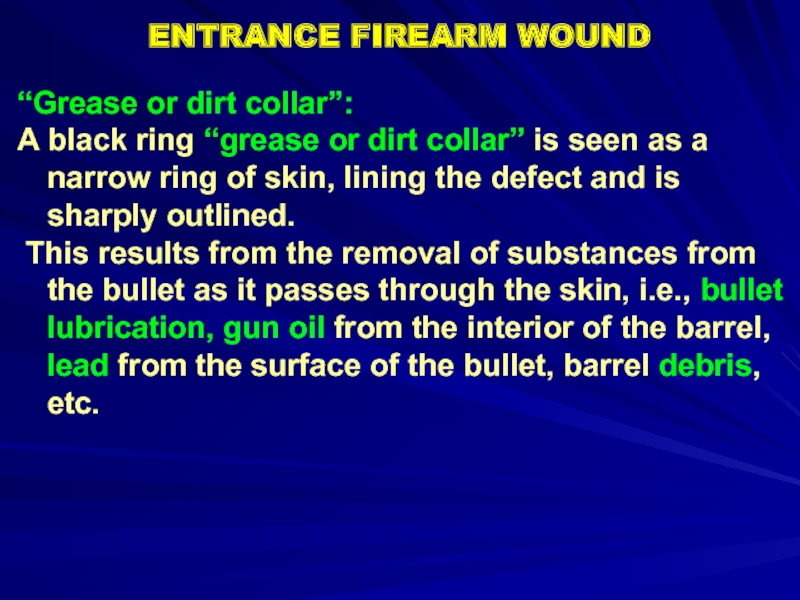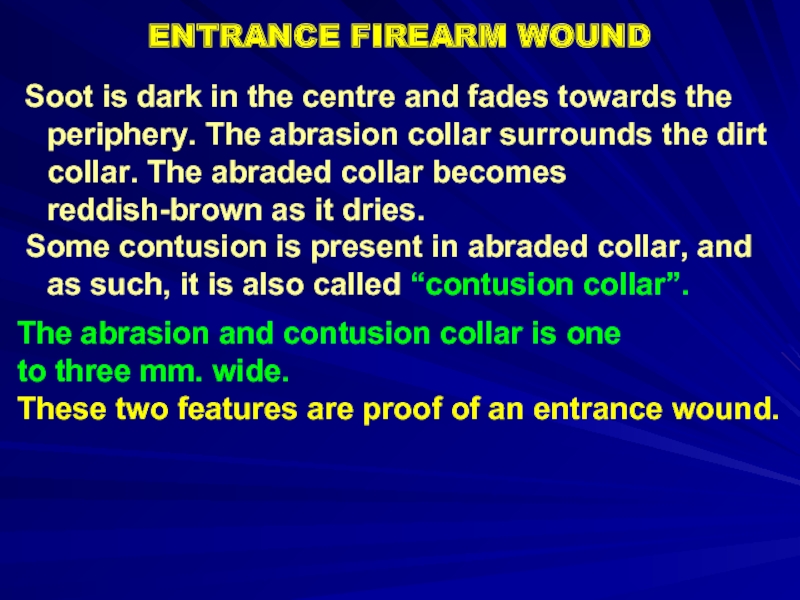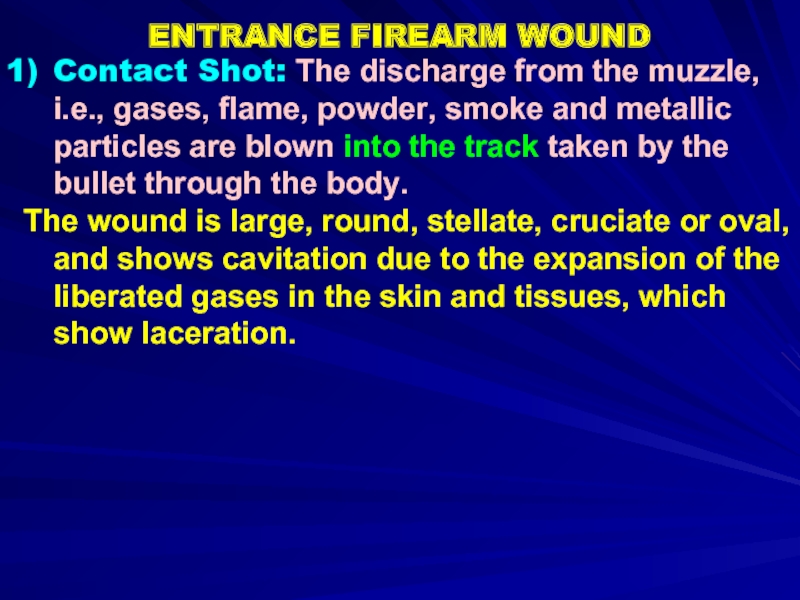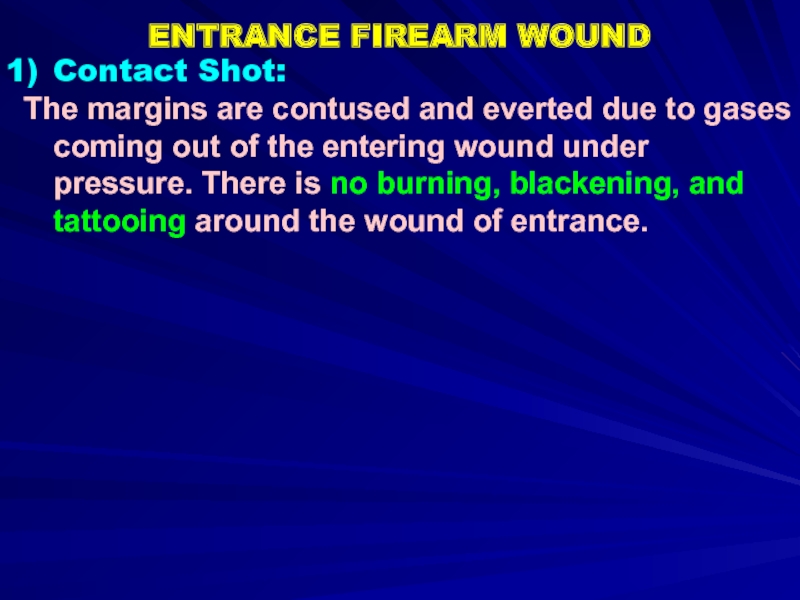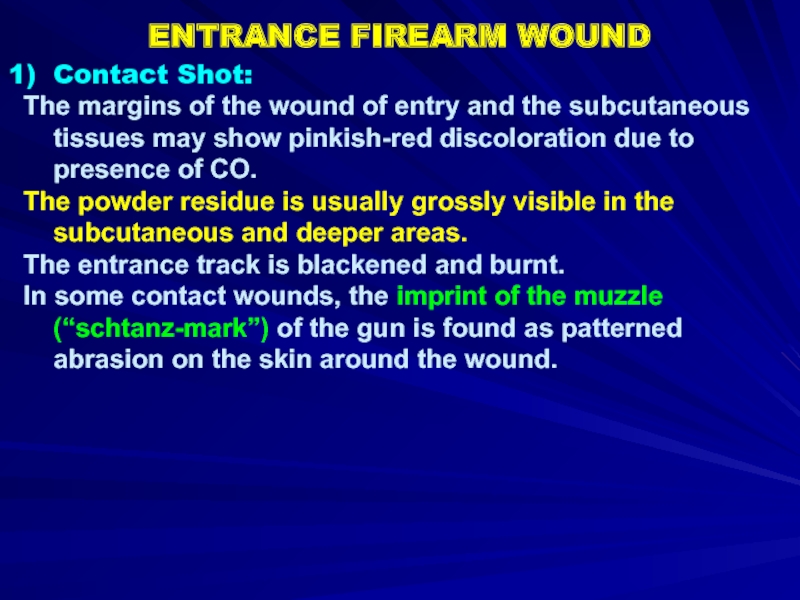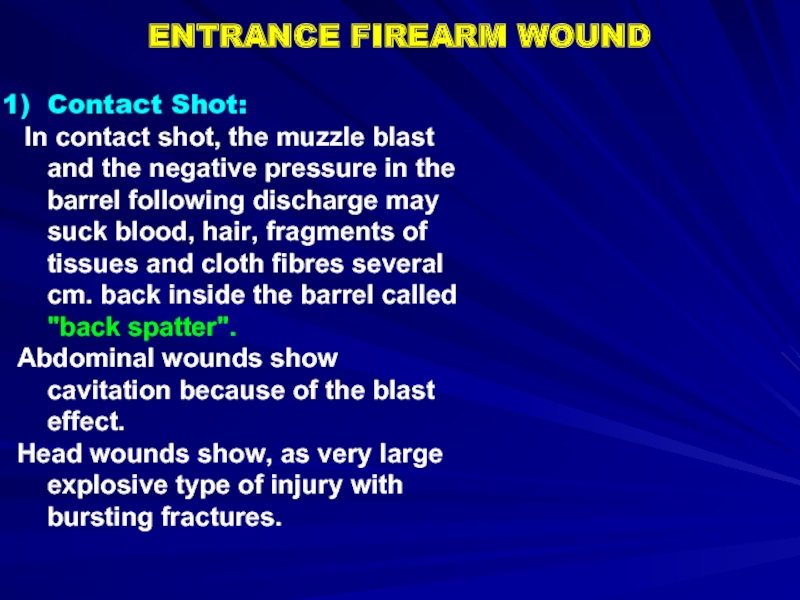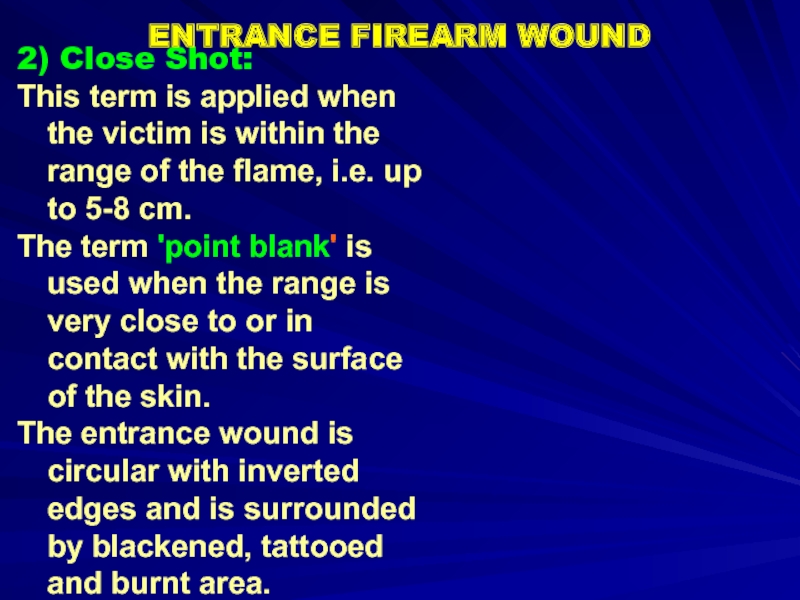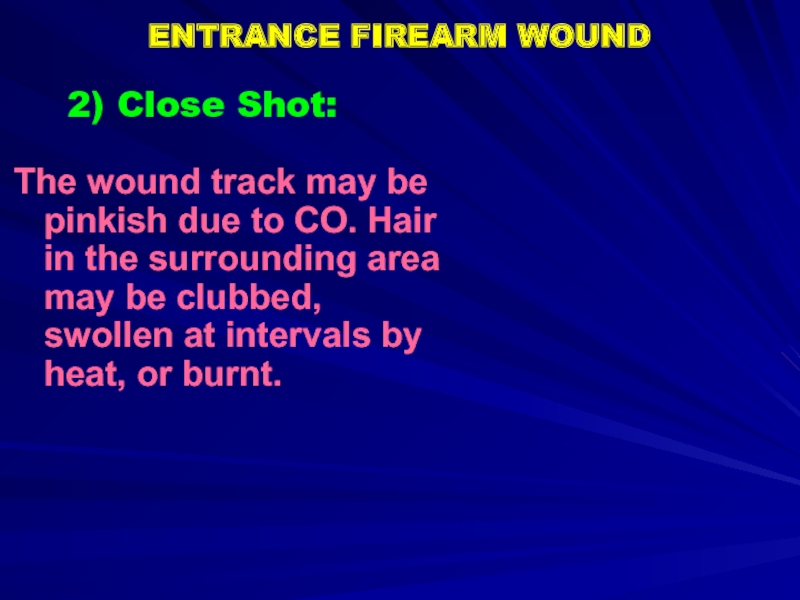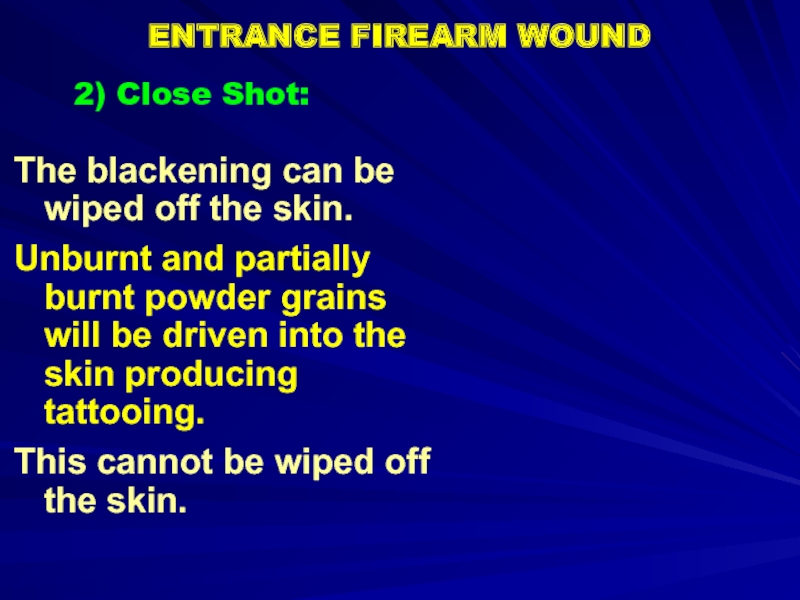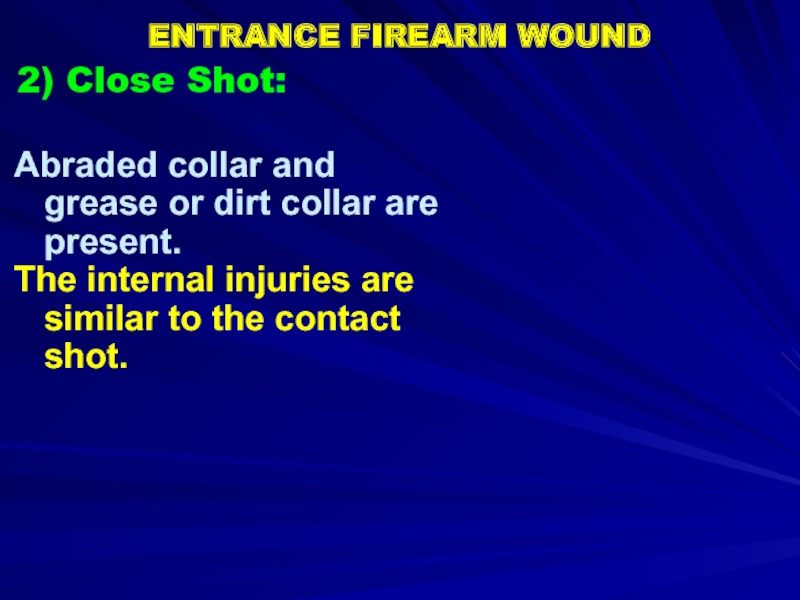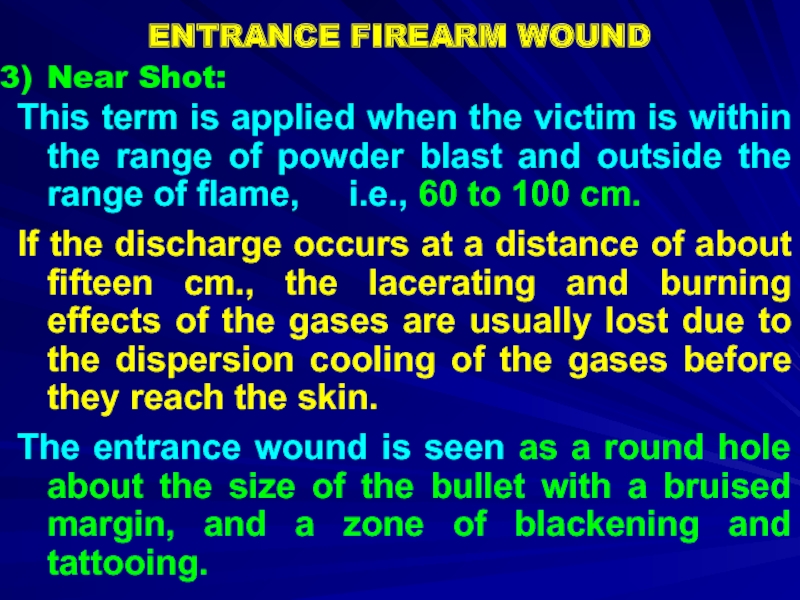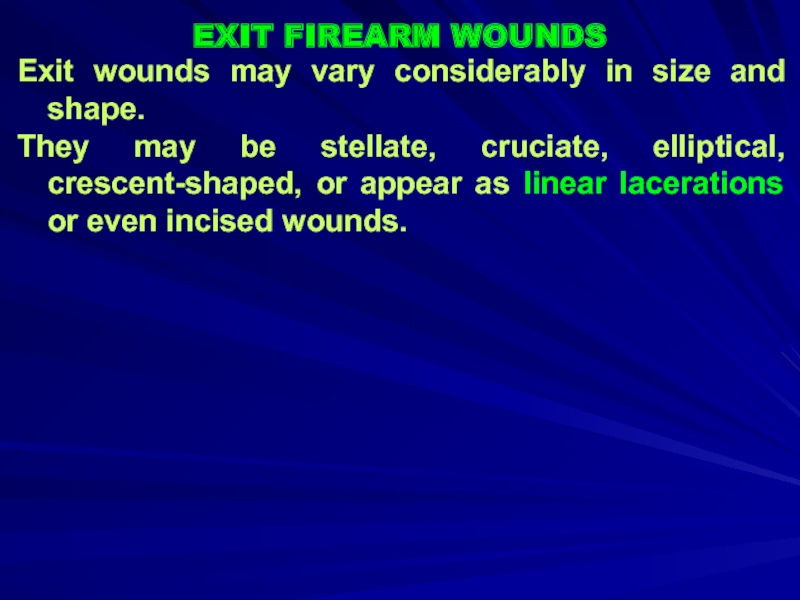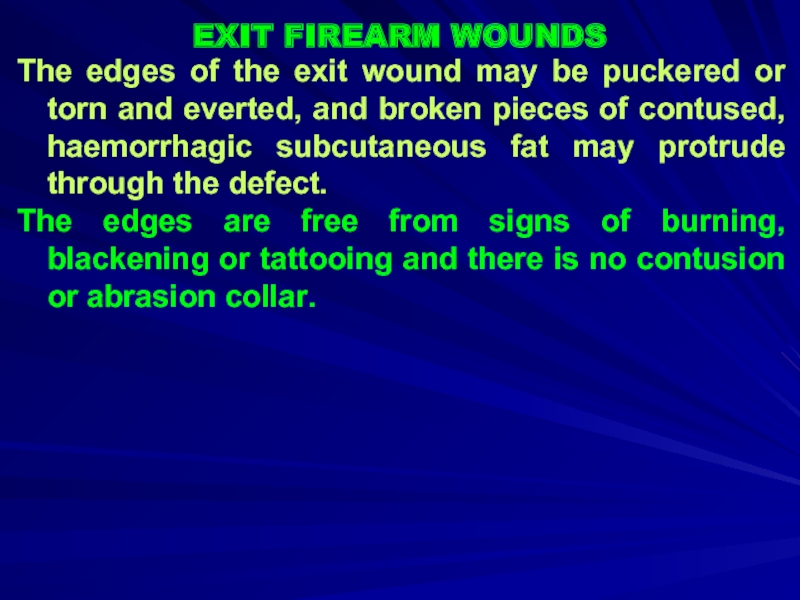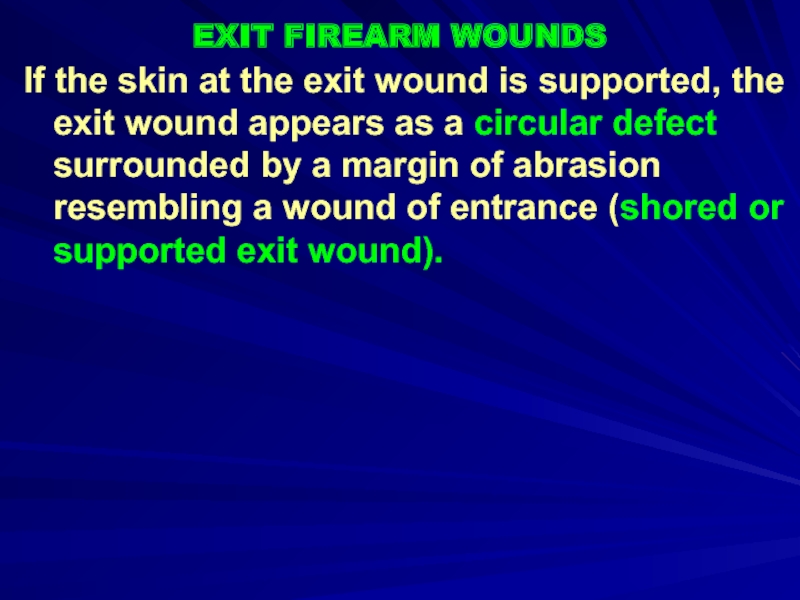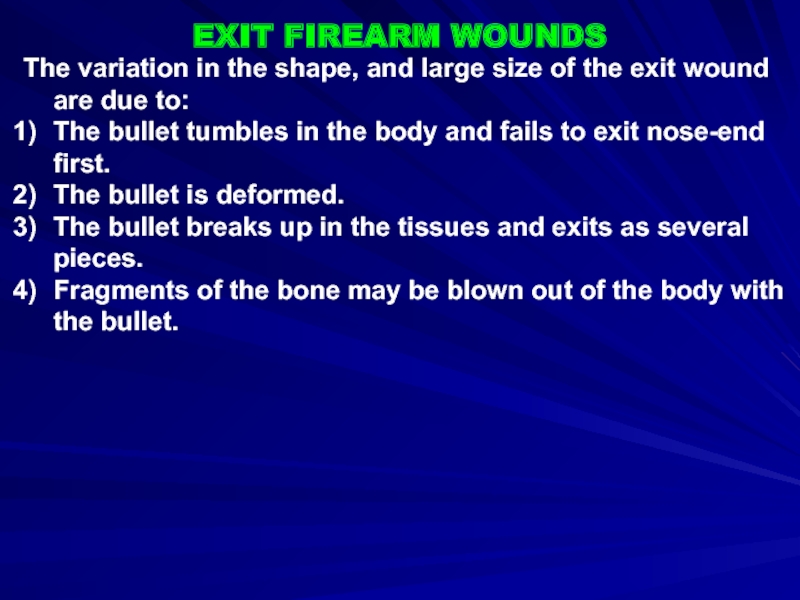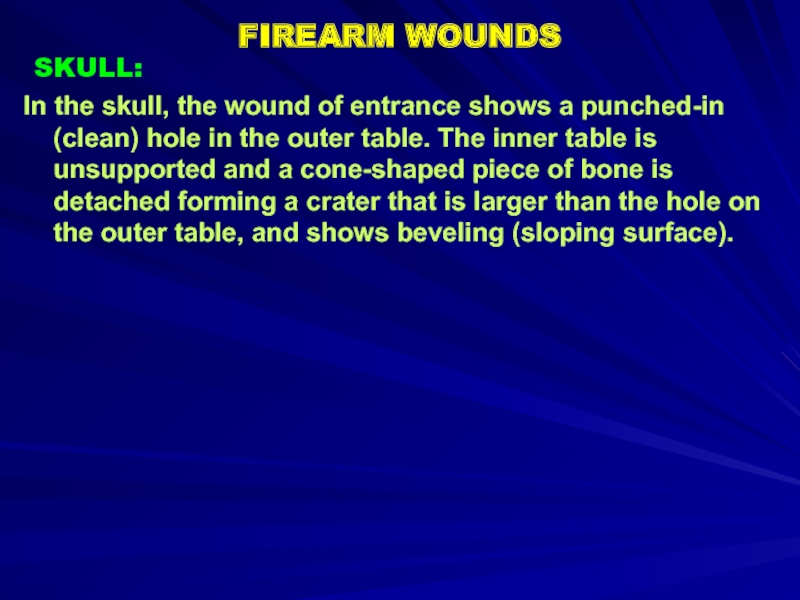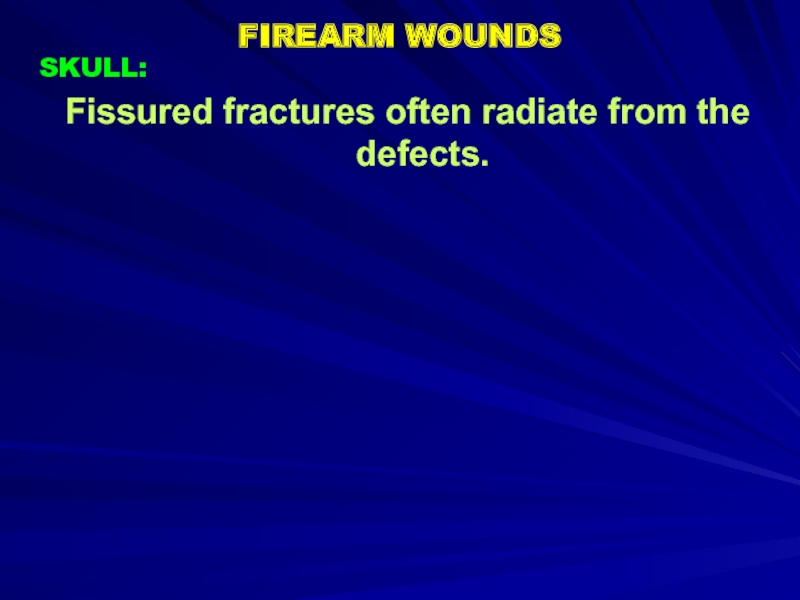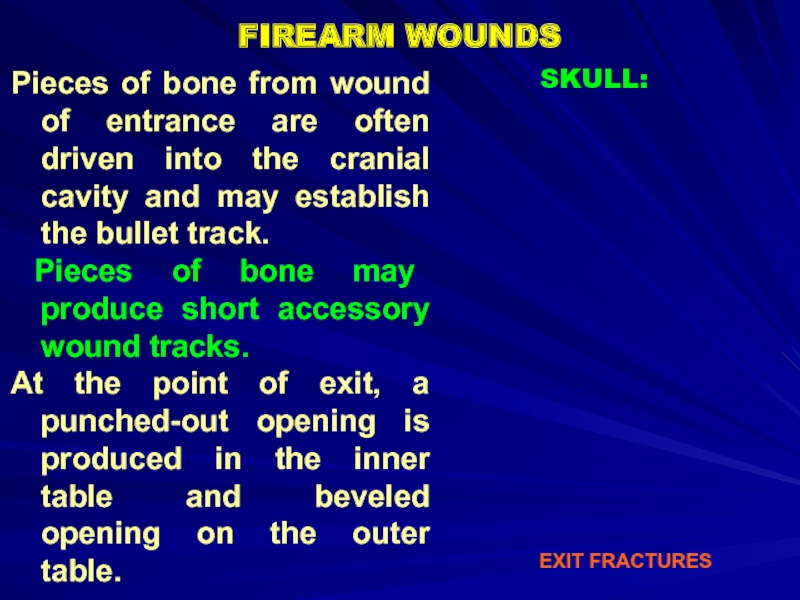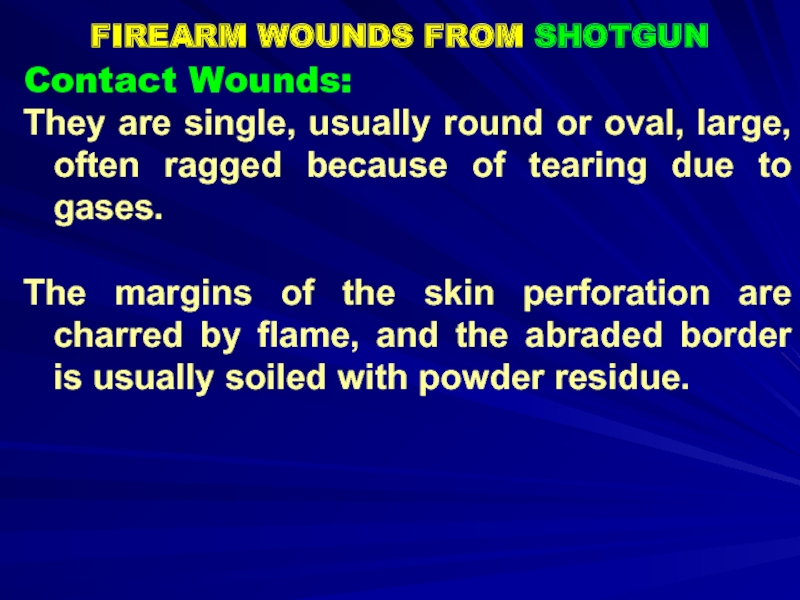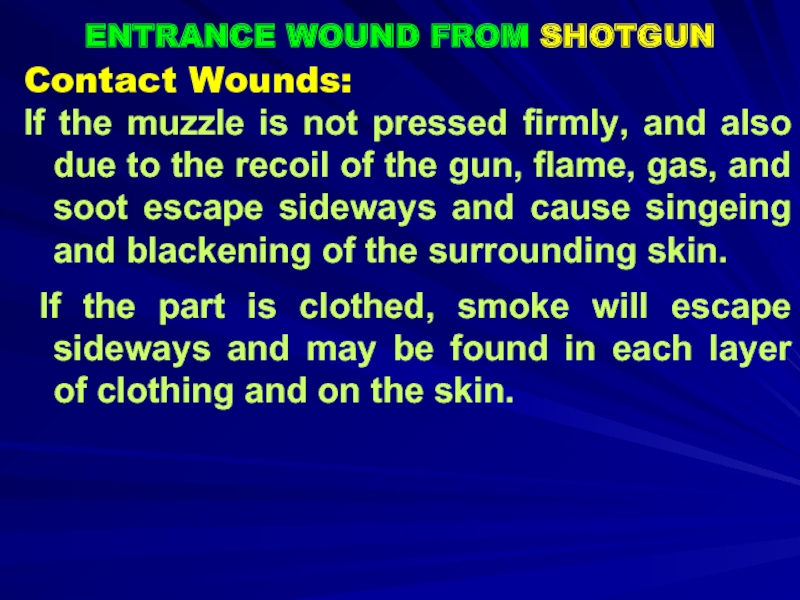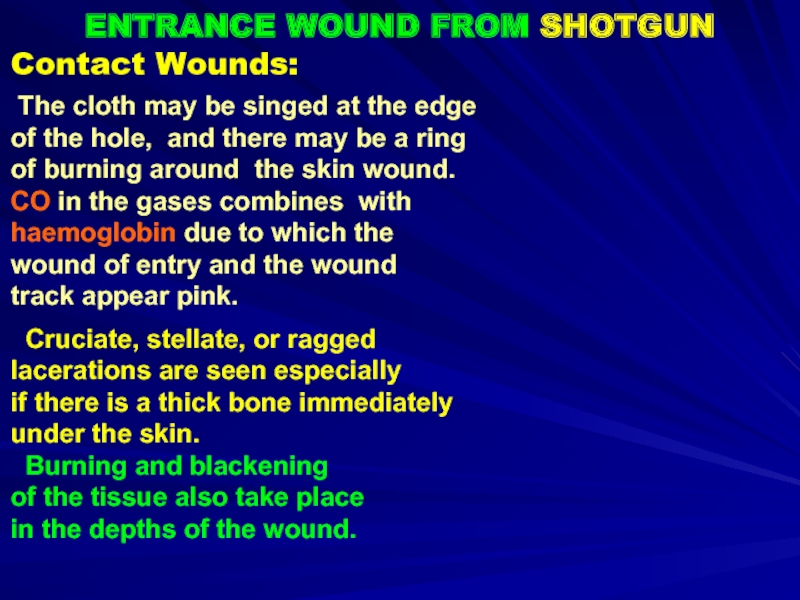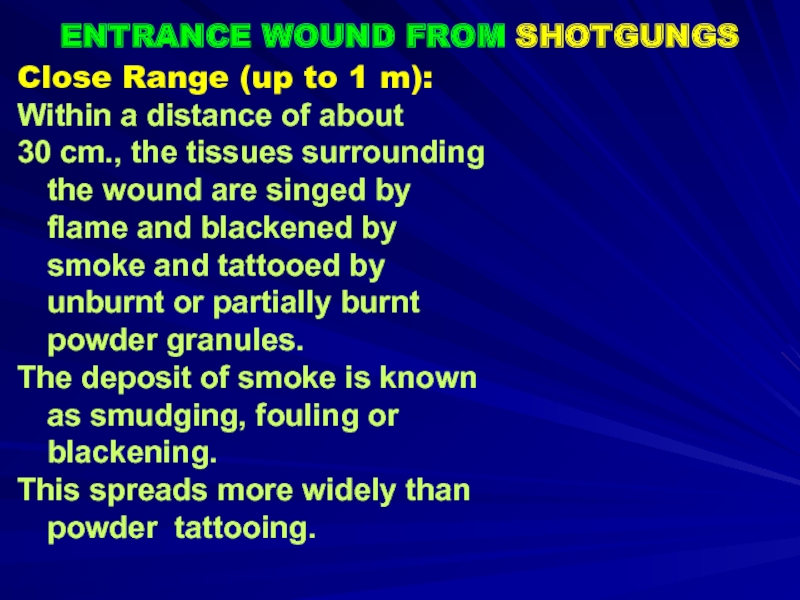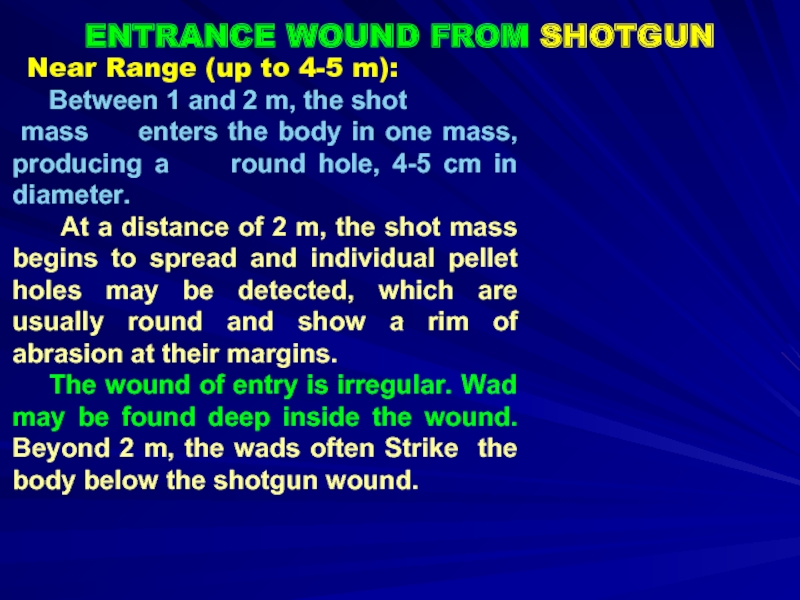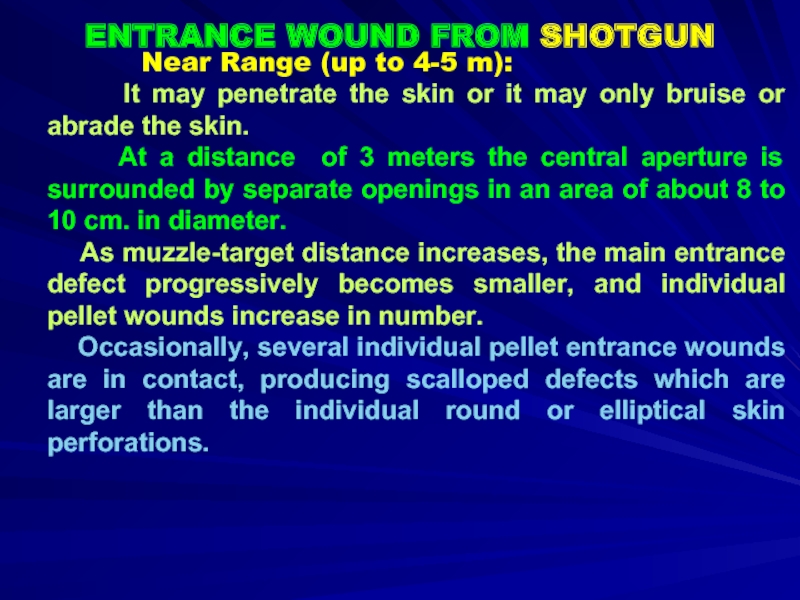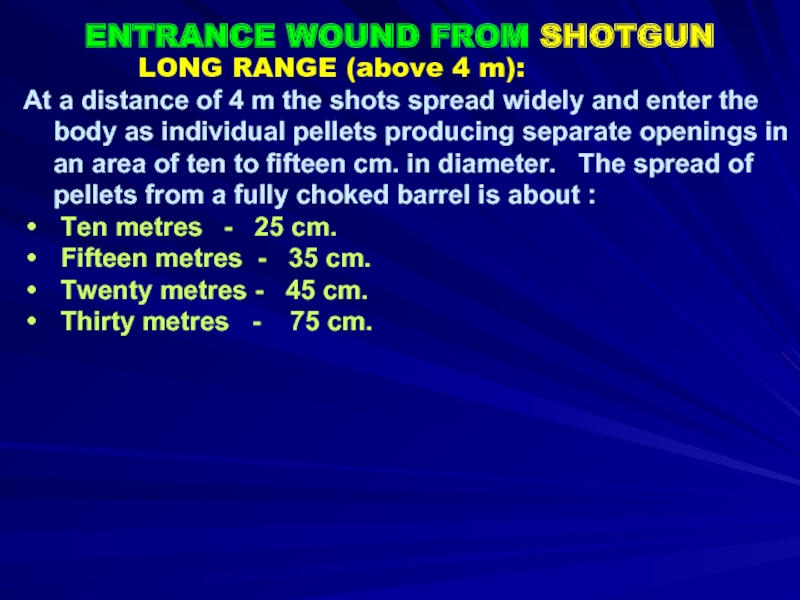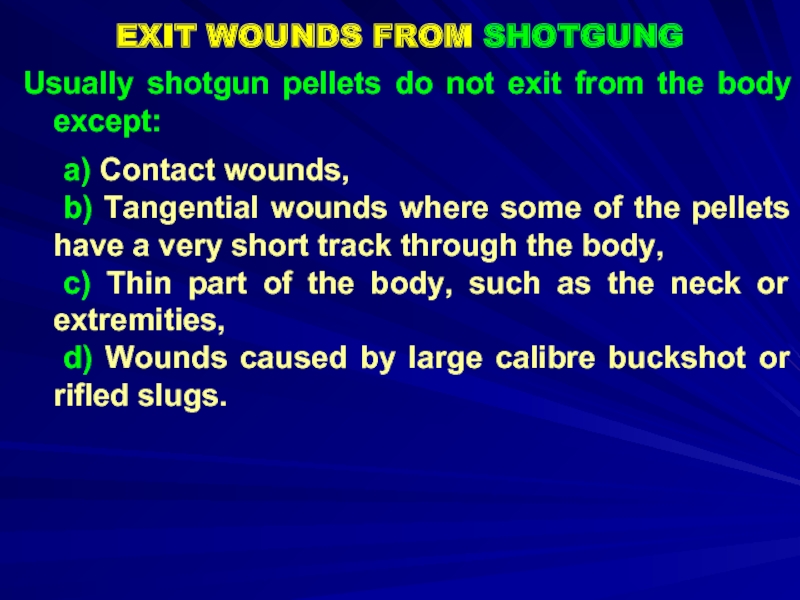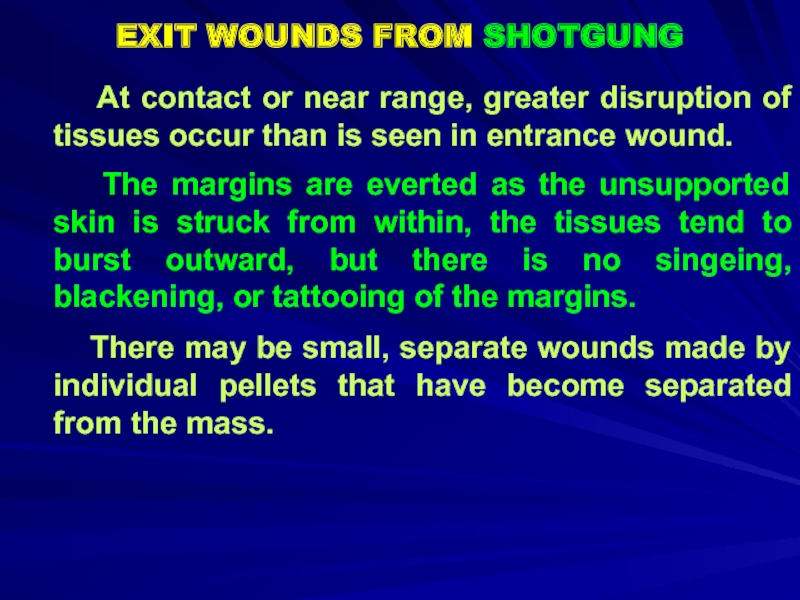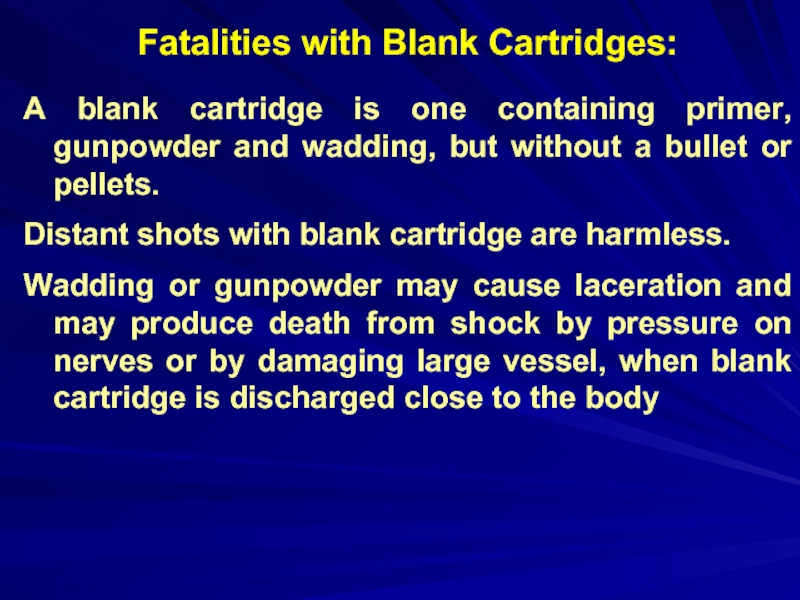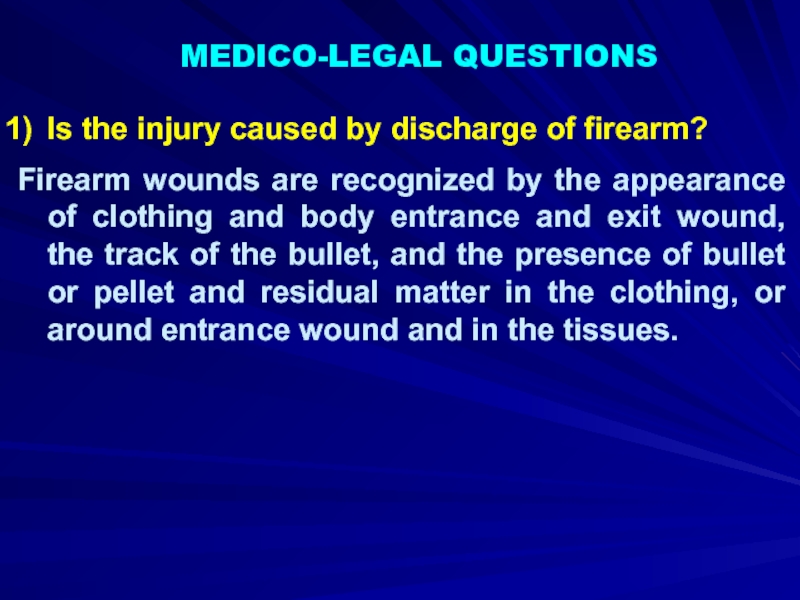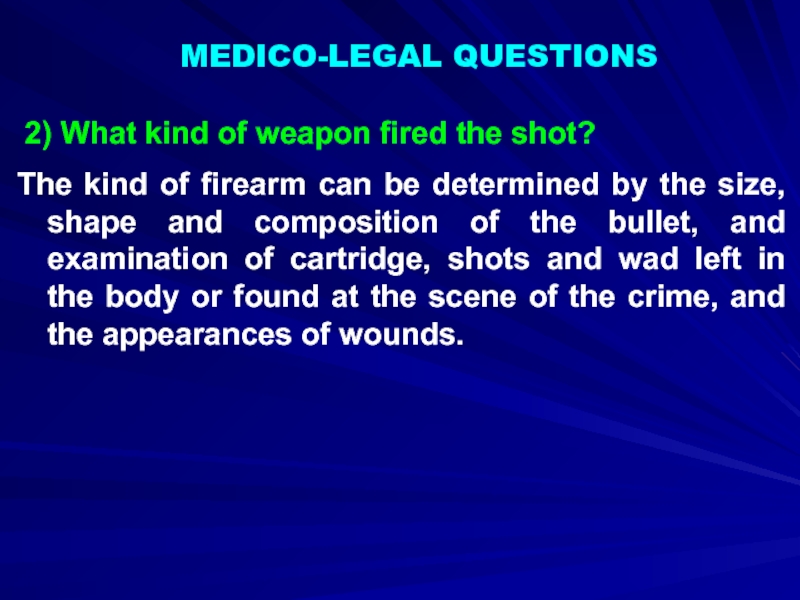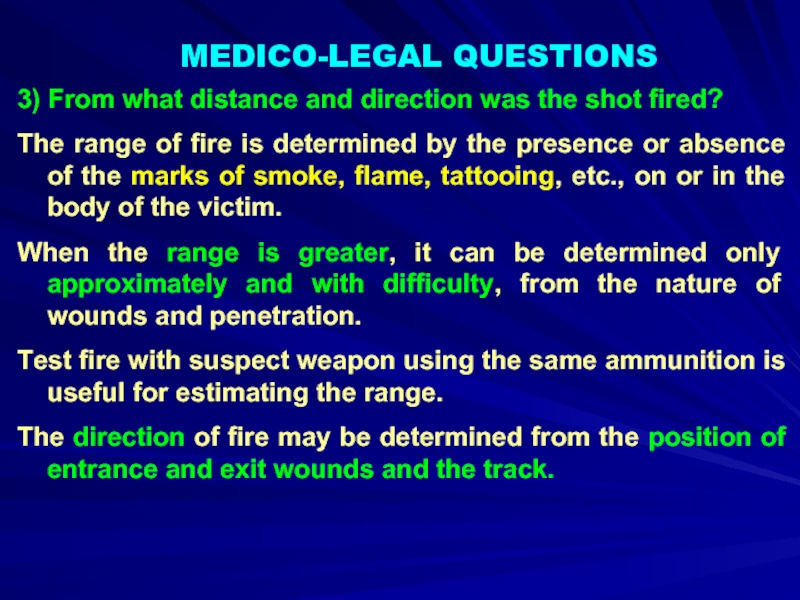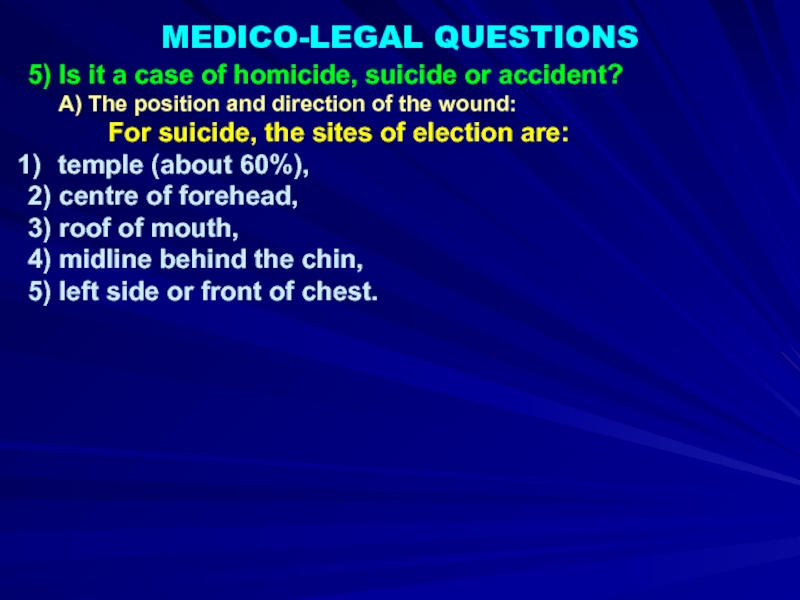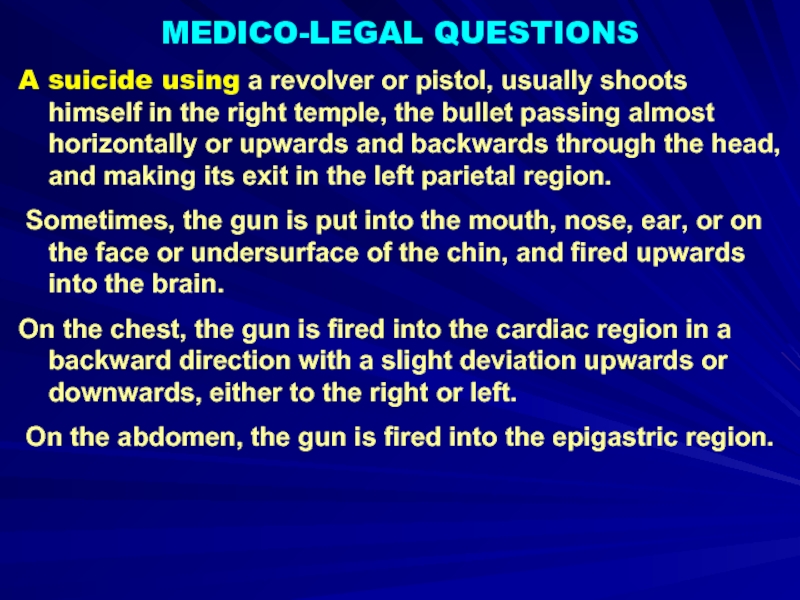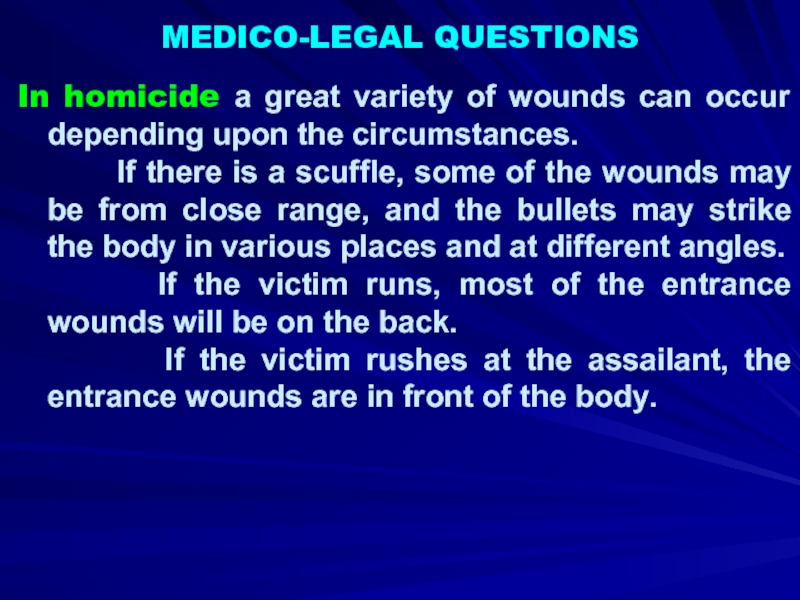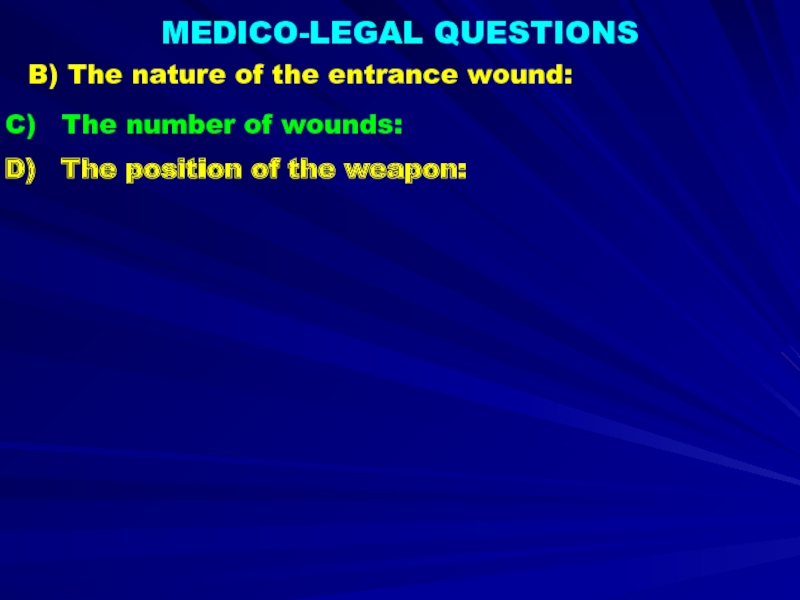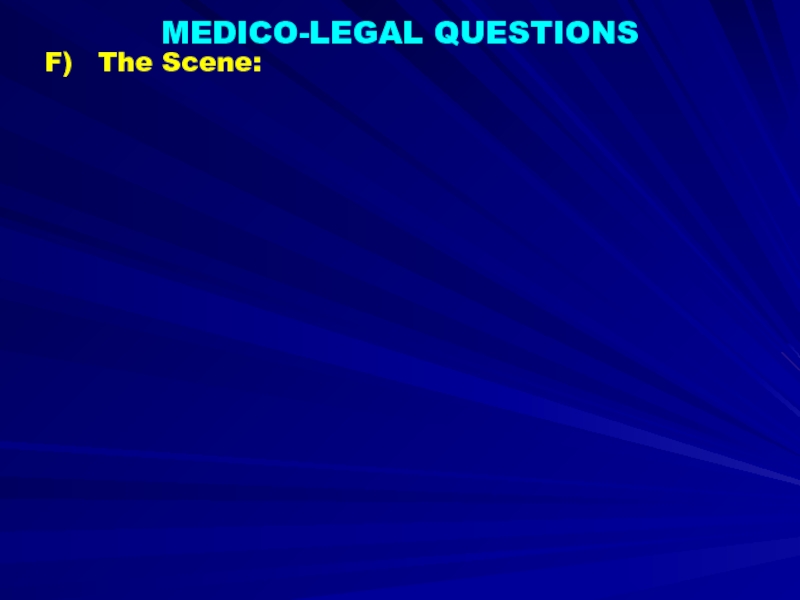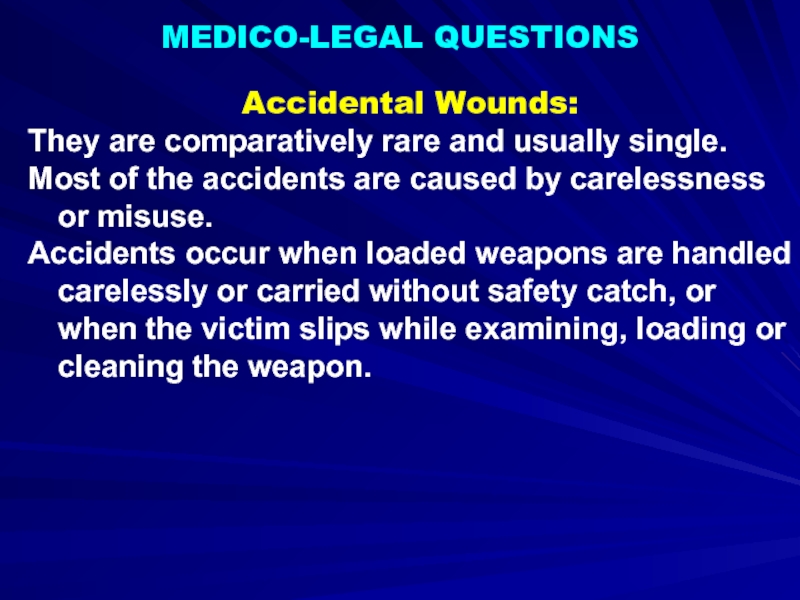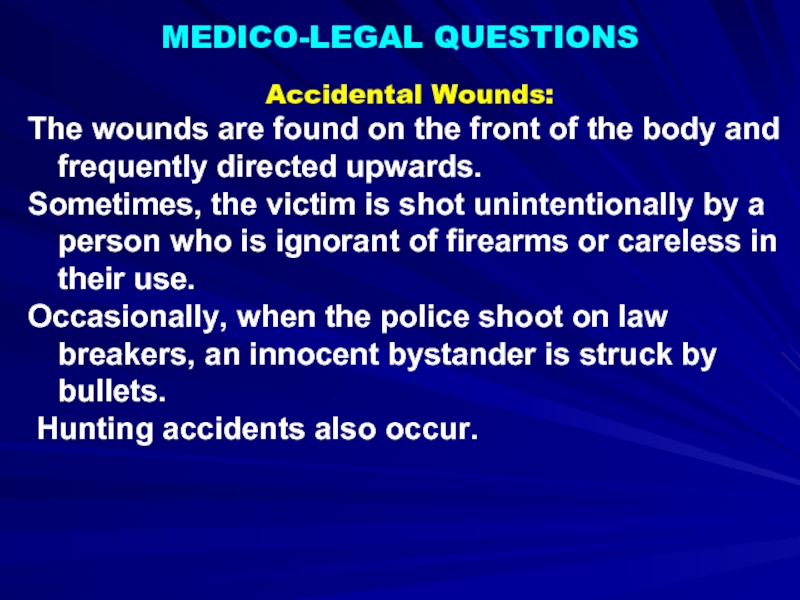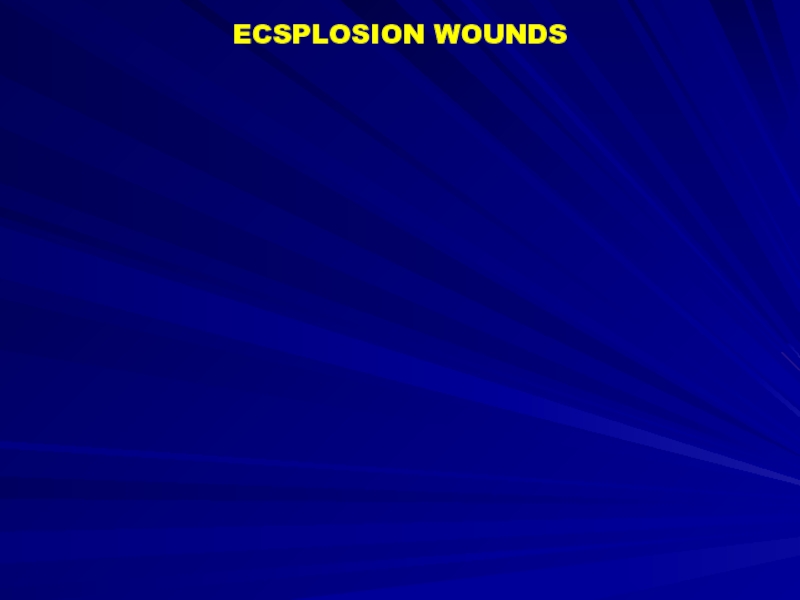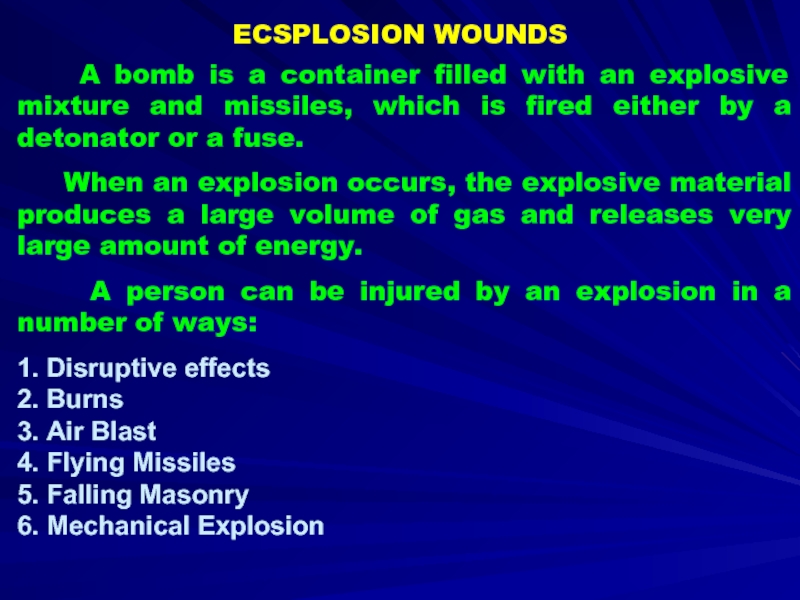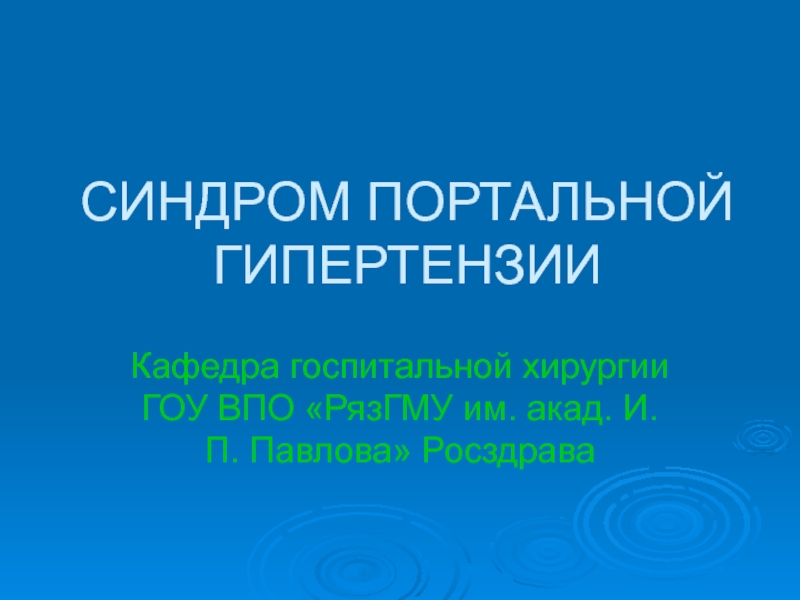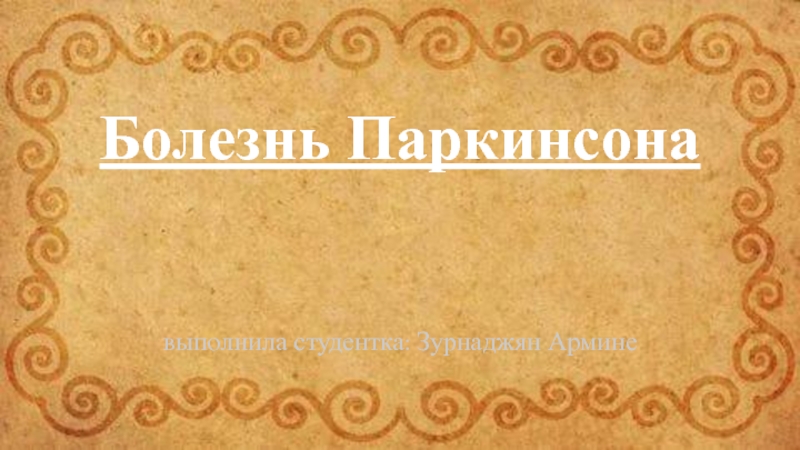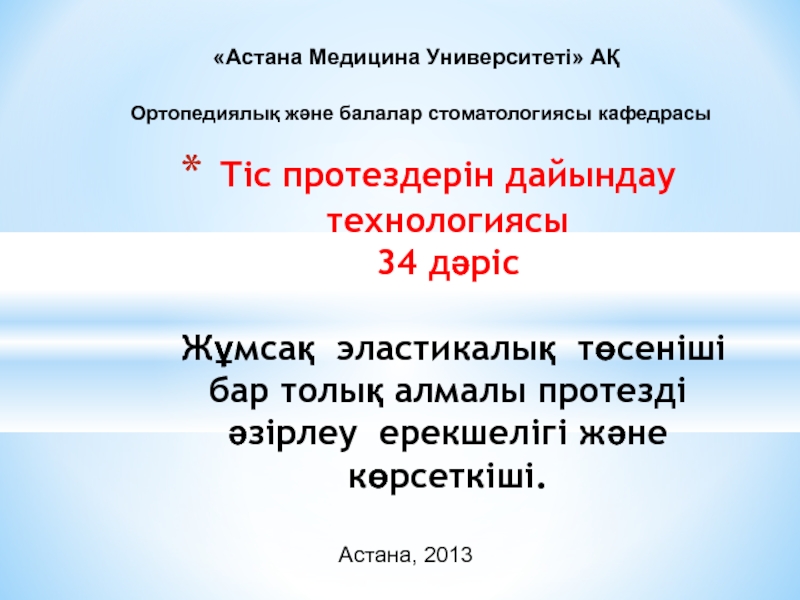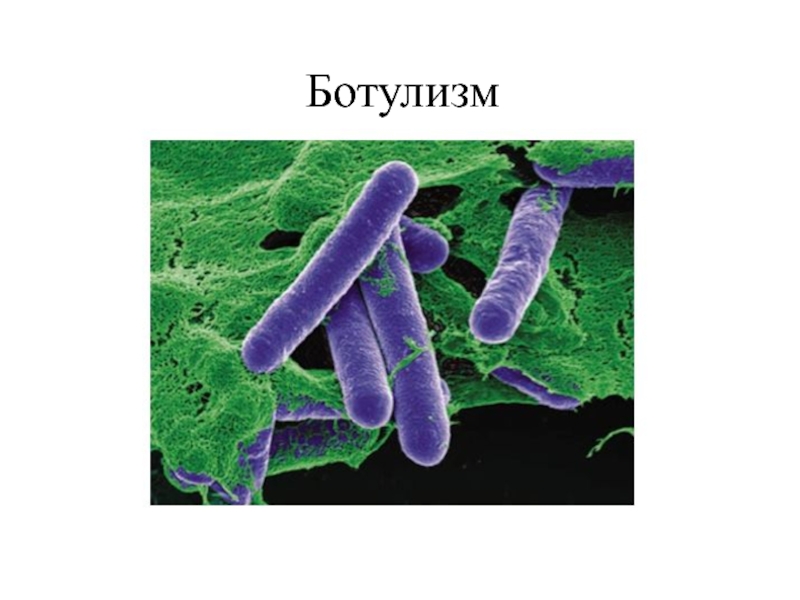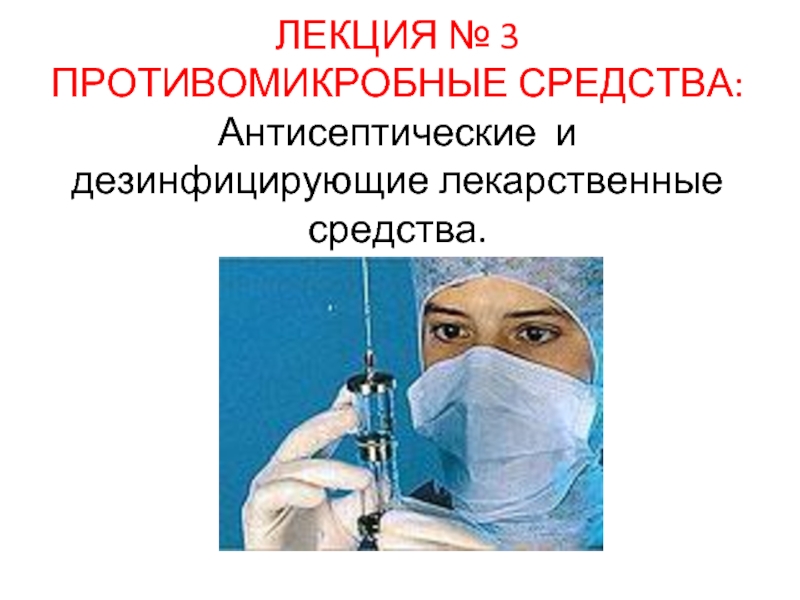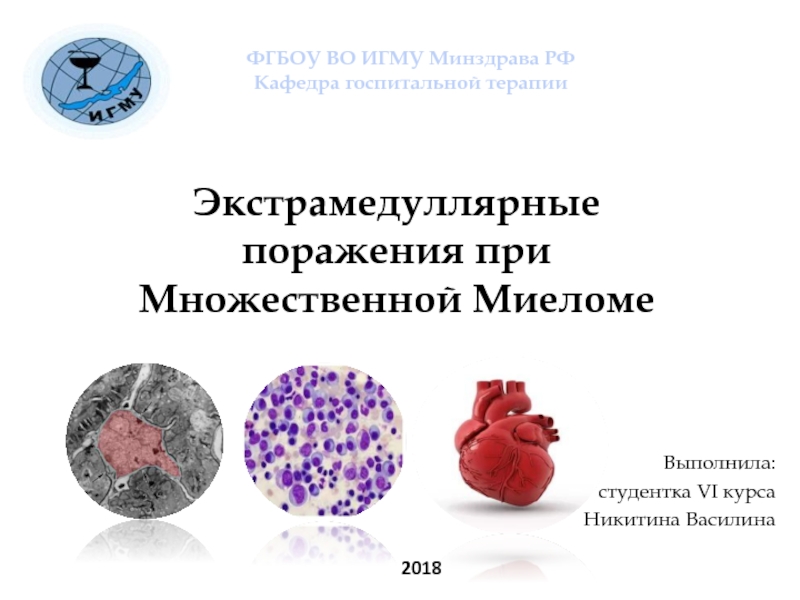FIREARM INJURIES
- Главная
- Разное
- Дизайн
- Бизнес и предпринимательство
- Аналитика
- Образование
- Развлечения
- Красота и здоровье
- Финансы
- Государство
- Путешествия
- Спорт
- Недвижимость
- Армия
- Графика
- Культурология
- Еда и кулинария
- Лингвистика
- Английский язык
- Астрономия
- Алгебра
- Биология
- География
- Детские презентации
- Информатика
- История
- Литература
- Маркетинг
- Математика
- Медицина
- Менеджмент
- Музыка
- МХК
- Немецкий язык
- ОБЖ
- Обществознание
- Окружающий мир
- Педагогика
- Русский язык
- Технология
- Физика
- Философия
- Химия
- Шаблоны, картинки для презентаций
- Экология
- Экономика
- Юриспруденция
Firearm injuries презентация
Содержание
- 1. Firearm injuries
- 2. FIREARM INJURIES Firearm injuries are meeting in
- 3. FORENSIC BALLISTICS Firearm is any instrument which
- 4. FORENSIC BALLISTICS General Make-up and Mechanism:
- 5. FORENSIC BALLISTICS General Make-up and Mechanism:
- 6. CLASSIFICATION I. Rifled weapons : 1) Rifles.
- 7. Rifled weapons Rifles Single-shot pistols Revolvers
- 8. Rifled weapons - the bore is cut
- 9. RIFLED ARMS 2) Revolvers: Revolvers are so-called
- 10. RIFLED ARMS 3) Automatic Pistol (machine guns)
- 11. RIFLED ARMS Calibre of Rifled weapons
- 12. The shotgun cartridge Calibre of the shotgun:
- 13. The shotgun cartridge The cartridge case
- 14. RIFLED ARMS Primers:
- 15. RIFLED ARMS Powders: Black
- 16. RIFLED ARMS Bullets: The traditional bullet
- 17. MEDICO-LEGAL QUESTIONS 1) Is the
- 18. FIREARM WOUNDS Entrance wound:
- 19. FIREARM WOUNDS Entrance wound: Entrance
- 20. FIREARM WOUNDS Accompanying Components of a Shot
- 21. FIREARM WOUNDS Entrance wound: The
- 22. Next signs of entrance wound are: The
- 23. ENTRANCE FIREARM WOUND After the bullet has
- 24. “Grease or dirt collar”: A black
- 25. Soot is dark in the
- 26. ENTRANCE FIREARM WOUND Contact Shot: The discharge
- 27. ENTRANCE FIREARM WOUND Contact Shot: The
- 28. Contact Shot: The margins of the
- 29. Contact Shot: In contact shot,
- 30. Contact Shot: This results in undermined,
- 31. 2) Close Shot: This term is
- 32. The wound track may be pinkish due
- 33. The blackening can be wiped off the
- 34. Abraded collar and grease or dirt collar
- 35. Near Shot: This term is applied
- 36. ENTRANCE FIREARM WOUND 4) Distant Shot:
- 37. Exit wounds may vary considerably in size
- 38. The edges of the exit wound may
- 39. EXIT FIREARM WOUNDS If the skin at
- 40. EXIT FIREARM WOUNDS Many shored exit wounds
- 41. The variation in the shape, and large
- 42. FIREARM WOUNDS In the skull, the wound
- 43. FIREARM WOUNDS Fissured fractures often radiate from the defects. SKULL:
- 44. FIREARM WOUNDS Pieces of bone from wound
- 45. The character of a wound depends on
- 46. Contact Wounds: They are single, usually
- 47. Contact Wounds: As the gases are
- 48. Contact Wounds: These particles cause haemorrhage
- 49. Contact Wounds: If the muzzle is
- 50. Contact Wounds: ENTRANCE WOUND FROM
- 51. Close Range (up to 1 m):
- 52. Close Range (up to 1 m):
- 53. Near Range (up to
- 56. Usually shotgun pellets do not exit from
- 57. At contact or
- 58. Fatalities with Blank Cartridges: A
- 59. Is the injury caused by discharge of
- 60. 2) What kind of weapon
- 61. 3) From what distance and direction was
- 62. 4) When was the firearm discharged?
- 63. MEDICO-LEGAL QUESTIONS 5) Is it a
- 64. MEDICO-LEGAL QUESTIONS A suicide using a
- 65. MEDICO-LEGAL QUESTIONS In homicide a great
- 66. MEDICO-LEGAL QUESTIONS B) The nature of
- 67. MEDICO-LEGAL QUESTIONS The Scene:
- 68. MEDICO-LEGAL QUESTIONS Accidental Wounds: They
- 69. MEDICO-LEGAL QUESTIONS Accidental Wounds: The
- 70. ECSPLOSION WOUNDS
- 71. A bomb is a
Слайд 1
ZAPOROZHIAL STATE MEDICAL UNIVERSITY
THE DEPARTMENT OF PATHOLOGICAL ANATOMY and FORENSIC MEDICINE
lecture
Слайд 2FIREARM INJURIES
Firearm injuries are meeting in our region rarely.
The doctor of any specielty must know the injuries from action of shotgun because may be attracted for examination of scene of occurrence.
Слайд 3FORENSIC BALLISTICS
Firearm is any instrument which discharges
a missile by the
Forensic ballistics is the science dealing with the investigation of firearms, ammunition and the problems arising from their use.
Слайд 4FORENSIC BALLISTICS
General Make-up and Mechanism:
Firearms consist of a metal barrel
which is closed at the back end and is called the breech end and the front open end is called the muzzle end.
Слайд 5FORENSIC BALLISTICS
General Make-up and Mechanism:
The inside of the barrel consists
1) The chamber, at the breech end to accommodate the cartridge,
2) the taper, connects the chamber to the bore,
3) the bore, which lies between the taper and the muzzle.
Слайд 6CLASSIFICATION
I. Rifled weapons :
1) Rifles.
2) Single-shot pistols.
3) Revolvers.
4)
5) True automatic weapons (machine-guns).
II. Smooth-bored weapons (shotgun):
1) Single barrel.
2) Double barrel.
3) Semi-automatic.
Слайд 7Rifled weapons
Rifles
Single-shot pistols
Revolvers
Automatic pistols
True automatic
weapons
(machine-guns)
Слайд 8Rifled weapons - the bore is cut internally with a number
These grooves are called "rifling", and the projecting ridges between these grooves are called "lands“ .
Слайд 9RIFLED ARMS
2) Revolvers:
Revolvers are so-called because the ammunition is put in
Rifle:
A rifle is a gun with a long barrel,
the bore of which is rifled.
Слайд 10RIFLED ARMS
3) Automatic Pistol (machine guns)
In this, when a cartridge is
Слайд 11RIFLED ARMS
Calibre of Rifled weapons
The dimension of the
Most often are meeting caliber
5, 45; 7,62; 9,0-10,0
Cartridge:
It consists of a metal cylinder with a flat base. The gunpowder lies between the detonator and the bullet.
Слайд 12The shotgun cartridge
Calibre of the shotgun:
it is measured by the
of the barrel .
The shotgun cartridge consists of a case of short metal cylinder which is continuous with a cardboard or plastic cylinder.
The length of the cartridge varies from 5-7 cm.
Слайд 13The shotgun cartridge
The cartridge case is filled as follows from the
- gunpowder,
- a thick felt-wad with cardboard discs lying in front and behind it,
- the shot,
- and finally the retaining cardboard disc, over which the edges of the cartridge cylinder walls are pressed.
Слайд 14RIFLED ARMS
Primers:
Centre fire rifle and pistol primers
The blow of the firing pin on the primer cup crushes the priming mixture against the anvil centre and burns it, which then flashes through the flash-holes (fire-holes or vents) and burns the powder.
Слайд 15RIFLED ARMS
Powders:
Black Powder:
It consists of potassium nitrate
2) Smokeless Powder:
Nitrocellulose (single base) or nitroglycerine and nitrocellulose (double base), produce much less flame and smoke and are more completely burnt than black powder. One gram produces 12,000 to 13,000 c.c. of gases.
Слайд 16RIFLED ARMS
Bullets:
The traditional bullet is made of soft metal and
The metal is lead with varying amounts of antimony added to provide hardness.
The caliber of a bullet is its cross-sectional diameter.
In revolver and pistol, the bullet is short and the point usually round.
In rifle, the bullet is elongated with pointed end.
Слайд 17
MEDICO-LEGAL QUESTIONS
1) Is the injury caused by discharge of firearm?
3) From what distance and direction was the shot fired?
4) When was the firearm discharged?
5) Where are an entrance and an exit wounds?
6) What was direction of wound canal?
7) How many shots have been effected, which shot was fatal?
8) Whether there are signs of injuries which can be caused by own hand?
Слайд 18FIREARM WOUNDS
Entrance wound:
One of the most important attributes of
At attempt to pull together edges of a wound between fingers it is formed pleats on the skin.
WOUNDS FROM REVOLVERS AND AUTOMATIC PISTOLS
Слайд 19FIREARM WOUNDS
Entrance wound:
Entrance wound are classified on the distance
contact shot,
close shot,
near shot
and distant (long) shot.
WOUNDS FROM REVOLVERS AND AUTOMATIC PISTOLS
Слайд 20FIREARM WOUNDS
Accompanying Components of a Shot
(additional factors)
Flame
Powder gases
Soot black
Unburnt and
WOUNDS FROM REVOLVERS AND AUTOMATIC PISTOLS
Слайд 21FIREARM WOUNDS
Entrance wound:
The flame extends up to
3-5 cm.
Powder gases up to 5-10 cm.;
Soot black – 30-35cm (Blackening)
and unburnt and partially burnt powder grains and small metallic particles up
to 100 cm. (Tattooing)
WOUNDS FROM REVOLVERS AND PISTOLS
Слайд 22Next signs of entrance wound are: The Abrasion Collar (marginal abrasion)
As the bullet strikes the skin, it first indents and then stretches the skin surface, so that perforation takes place through a tense area.
ENTRANCE FIREARM WOUND
Слайд 23ENTRANCE FIREARM WOUND
After the bullet has perforated the skin, the elasticity
The skin is abraded around the hole due to rubbing of the gyrating body of the bullet against the inverted epidermis.
Слайд 24“Grease or dirt collar”:
A black ring “grease or dirt collar”
This results from the removal of substances from the bullet as it passes through the skin, i.e., bullet lubrication, gun oil from the interior of the barrel, lead from the surface of the bullet, barrel debris, etc.
ENTRANCE FIREARM WOUND
Слайд 25
Soot is dark in the centre and fades towards the
Some contusion is present in abraded collar, and as such, it is also called “contusion collar”.
The abrasion and contusion collar is one
to three mm. wide.
These two features are proof of an entrance wound.
ENTRANCE FIREARM WOUND
Слайд 26ENTRANCE FIREARM WOUND
Contact Shot: The discharge from the muzzle, i.e., gases,
The wound is large, round, stellate, cruciate or oval, and shows cavitation due to the expansion of the liberated gases in the skin and tissues, which show laceration.
Слайд 27ENTRANCE FIREARM WOUND
Contact Shot:
The margins are contused and everted due
Слайд 28Contact Shot:
The margins of the wound of entry and the
The powder residue is usually grossly visible in the subcutaneous and deeper areas.
The entrance track is blackened and burnt.
In some contact wounds, the imprint of the muzzle (“schtanz-mark”) of the gun is found as patterned abrasion on the skin around the wound.
ENTRANCE FIREARM WOUND
Слайд 29Contact Shot:
In contact shot, the muzzle blast and the
Abdominal wounds show cavitation because of the blast effect.
Head wounds show, as very large explosive type of injury with bursting fractures.
ENTRANCE FIREARM WOUND
Слайд 30Contact Shot:
This results in undermined, ragged, cruciform opening with everted
A subcutaneous pocket containing blood mixed with gunpowder is formed by separation of the tissues. Soot may be deposited on the bone surrounding the bullet hole.
ENTRANCE FIREARM WOUND
Слайд 312) Close Shot:
This term is applied when the victim is
The term 'point blank' is used when the range is very close to or in contact with the surface of the skin.
The entrance wound is circular with inverted edges and is surrounded by blackened, tattooed and burnt area.
ENTRANCE FIREARM WOUND
Слайд 32The wound track may be pinkish due to CO. Hair in
ENTRANCE FIREARM WOUND
2) Close Shot:
Слайд 33The blackening can be wiped off the skin.
Unburnt and partially
This cannot be wiped off the skin.
ENTRANCE FIREARM WOUND
2) Close Shot:
Слайд 34Abraded collar and grease or dirt collar are present.
The internal
ENTRANCE FIREARM WOUND
2) Close Shot:
Слайд 35Near Shot:
This term is applied when the victim is within
If the discharge occurs at a distance of about fifteen cm., the lacerating and burning effects of the gases are usually lost due to the dispersion cooling of the gases before they reach the skin.
The entrance wound is seen as a round hole about the size of the bullet with a bruised margin, and a zone of blackening and tattooing.
ENTRANCE FIREARM WOUND
Слайд 36ENTRANCE FIREARM WOUND
4) Distant Shot:
The entrance wound is smaller than
The skin adjacent to the hole shows two zones, the inner of grease collar arid the outer of abraded collar.
Слайд 37Exit wounds may vary considerably in size and shape.
They may
EXIT FIREARM WOUNDS
Слайд 38The edges of the exit wound may be puckered or torn
The edges are free from signs of burning, blackening or tattooing and there is no contusion or abrasion collar.
EXIT FIREARM WOUNDS
Слайд 39EXIT FIREARM WOUNDS
If the skin at the exit wound is supported,
Слайд 40EXIT FIREARM WOUNDS
Many shored exit wounds are caused if a firm
Слайд 41The variation in the shape, and large size of the exit
The bullet tumbles in the body and fails to exit nose-end first.
The bullet is deformed.
The bullet breaks up in the tissues and exits as several pieces.
Fragments of the bone may be blown out of the body with the bullet.
EXIT FIREARM WOUNDS
Слайд 42FIREARM WOUNDS
In the skull, the wound of entrance shows a punched-in
SKULL:
Слайд 44FIREARM WOUNDS
Pieces of bone from wound of entrance are often driven
Pieces of bone may produce short accessory wound tracks.
At the point of exit, a punched-out opening is produced in the inner table and beveled opening on the outer table.
SKULL:
EXIT FRACTURES
Слайд 45The character of a wound depends on
the distance from which the
I. Entrance wound from shotguns:
FIREARM WOUNDS FROM SHOTGUN
The smoke (powder gases) extends up to 30 cm., Soot black up to 50-70 cm. and unburnt and partially burnt powder grains up to 100 cm. The cards travel for 2 metres, and wad for 2-6 metres. Up to a distance of three metres wadding can produce minor injury.
Слайд 46Contact Wounds:
They are single, usually round or oval, large, often
The margins of the skin perforation are charred by flame, and the abraded border is usually soiled with powder residue.
FIREARM WOUNDS FROM SHOTGUN
Слайд 47Contact Wounds:
As the gases are blasted within the wound, the
Particles of unburnt powder are driven to some distance through the wound, and some of them are found embedded in the wound.
FIREARM WOUNDS FROM SHOTGUN
Слайд 48Contact Wounds:
These particles cause haemorrhage in deeper tissues and in
If the contact is tight, muzzle impression (copy or recoil abrasion) is seen.
ENTRANCE WOUND FROM SHOTGUN
Слайд 49Contact Wounds:
If the muzzle is not pressed firmly, and also
If the part is clothed, smoke will escape sideways and may be found in each layer of clothing and on the skin.
ENTRANCE WOUND FROM SHOTGUN
Слайд 50Contact Wounds:
ENTRANCE WOUND FROM SHOTGUN
The cloth may be singed
of the hole, and there may be a ring
of burning around the skin wound.
CO in the gases combines with
haemoglobin due to which the
wound of entry and the wound
track appear pink.
Cruciate, stellate, or ragged
lacerations are seen especially
if there is a thick bone immediately
under the skin.
Burning and blackening
of the tissue also take place
in the depths of the wound.
Слайд 51Close Range (up to 1 m):
Within a distance of about
30 cm., the tissues surrounding the wound are singed by flame and blackened by smoke and tattooed by unburnt or partially burnt powder granules.
The deposit of smoke is known as smudging, fouling or blackening.
This spreads more widely than powder tattooing.
ENTRANCE WOUND FROM SHOTGUNGS
Слайд 52Close Range (up to 1 m):
The tissues within and around
The wound is single, circular or oval similar to contact wounds, though the blackening and tattooing are more extensive.
The margins of the skin wound may be clean-cut or slightly ragged.
If the powder is smokeless, there may be grey or white deposit on the skin round the wound.
The deeper tissues show marked disruption.
Felt, wads or plastic cups from the cartridge will be found in the depths of the wound.
ENTRANCE WOUND FROM SHOTGUNGS
Слайд 53 Near Range (up to 4-5 m):
mass enters the body in one mass, producing a round hole, 4-5 cm in diameter.
At a distance of 2 m, the shot mass begins to spread and individual pellet holes may be detected, which are usually round and show a rim of abrasion at their margins.
The wound of entry is irregular. Wad may be found deep inside the wound. Beyond 2 m, the wads often Strike the body below the shotgun wound.
ENTRANCE WOUND FROM SHOTGUN
Слайд 54 Near Range (up to
It may penetrate the skin or it may only bruise or abrade the skin.
At a distance of 3 meters the central aperture is surrounded by separate openings in an area of about 8 to 10 cm. in diameter.
As muzzle-target distance increases, the main entrance defect progressively becomes smaller, and individual pellet wounds increase in number.
Occasionally, several individual pellet entrance wounds are in contact, producing scalloped defects which are larger than the individual round or elliptical skin perforations.
ENTRANCE WOUND FROM SHOTGUN
Слайд 55 LONG RANGE (above 4
At a distance of 4 m the shots spread widely and enter the body as individual pellets producing separate openings in an area of ten to fifteen cm. in diameter. The spread of pellets from a fully choked barrel is about :
Ten metres - 25 cm.
Fifteen metres - 35 cm.
Twenty metres - 45 cm.
Thirty metres - 75 cm.
ENTRANCE WOUND FROM SHOTGUN
Слайд 56Usually shotgun pellets do not exit from the body except:
a)
b) Tangential wounds where some of the pellets have a very short track through the body,
c) Thin part of the body, such as the neck or extremities,
d) Wounds caused by large calibre buckshot or rifled slugs.
EXIT WOUNDS FROM SHOTGUNG
Слайд 57 At contact or near range, greater disruption
The margins are everted as the unsupported skin is struck from within, the tissues tend to burst outward, but there is no singeing, blackening, or tattooing of the margins.
There may be small, separate wounds made by individual pellets that have become separated from the mass.
EXIT WOUNDS FROM SHOTGUNG
Слайд 58Fatalities with Blank Cartridges:
A blank cartridge is one containing primer, gunpowder
Distant shots with blank cartridge are harmless.
Wadding or gunpowder may cause laceration and may produce death from shock by pressure on nerves or by damaging large vessel, when blank cartridge is discharged close to the body
Слайд 59Is the injury caused by discharge of firearm?
Firearm wounds are recognized
MEDICO-LEGAL QUESTIONS
Слайд 60
2) What kind of weapon fired the shot?
The kind
MEDICO-LEGAL QUESTIONS
Слайд 613) From what distance and direction was the shot fired?
The
When the range is greater, it can be determined only approximately and with difficulty, from the nature of wounds and penetration.
Test fire with suspect weapon using the same ammunition is useful for estimating the range.
The direction of fire may be determined from the position of entrance and exit wounds and the track.
MEDICO-LEGAL QUESTIONS
Слайд 624) When was the firearm discharged?
Tissue reaction to firearm injury
MEDICO-LEGAL QUESTIONS
Слайд 63
MEDICO-LEGAL QUESTIONS
5) Is it a case of homicide, suicide or accident?
For suicide, the sites of election are:
temple (about 60%),
2) centre of forehead,
3) roof of mouth,
4) midline behind the chin,
5) left side or front of chest.
Слайд 64
MEDICO-LEGAL QUESTIONS
A suicide using a revolver or pistol, usually shoots himself
Sometimes, the gun is put into the mouth, nose, ear, or on the face or undersurface of the chin, and fired upwards into the brain.
On the chest, the gun is fired into the cardiac region in a backward direction with a slight deviation upwards or downwards, either to the right or left.
On the abdomen, the gun is fired into the epigastric region.
Слайд 65
MEDICO-LEGAL QUESTIONS
In homicide a great variety of wounds can occur depending
If there is a scuffle, some of the wounds may be from close range, and the bullets may strike the body in various places and at different angles.
If the victim runs, most of the entrance wounds will be on the back.
If the victim rushes at the assailant, the entrance wounds are in front of the body.
Слайд 66
MEDICO-LEGAL QUESTIONS
B) The nature of the entrance wound:
The number of
The position of the weapon:
Слайд 68
MEDICO-LEGAL QUESTIONS
Accidental Wounds:
They are comparatively rare and usually single.
Most
Accidents occur when loaded weapons are handled carelessly or carried without safety catch, or when the victim slips while examining, loading or cleaning the weapon.
Слайд 69
MEDICO-LEGAL QUESTIONS
Accidental Wounds:
The wounds are found on the front of
Sometimes, the victim is shot unintentionally by a person who is ignorant of firearms or careless in their use.
Occasionally, when the police shoot on law breakers, an innocent bystander is struck by bullets.
Hunting accidents also occur.
Слайд 71 A bomb is a container filled with an
When an explosion occurs, the explosive material produces a large volume of gas and releases very large amount of energy.
A person can be injured by an explosion in a number of ways:
1. Disruptive effects
2. Burns
3. Air Blast
4. Flying Missiles
5. Falling Masonry
6. Mechanical Explosion
ECSPLOSION WOUNDS
